You’ll hear “pole pole” a lot on a Kilimanjaro climb — and frankly anywhere in Tanzania. It means “slowly, slowly” in Kiswahili, but could be more loosely translated as “take it easy”, “relax”, or “don’t rush”. The latter is key to a successful Kilimanjaro climb. Especially, if you’re not super athletic and/or accustomed to high altitudes.
Here I’m sharing my personal impressions of the climb that I did end of November 2021. There are many different routes to climb Kilimanjaro and I picked the 7-day Lemosho route. It is designed to get climbers accustomed to high altitudes for a couple of days, before actually tackling the summit.
Kilimanjaro Intro
I’ll walk you through the climb chronologically, but let me first explain some basics. Mount Kilimanjaro is not part of a mountain range, but is a free standing volcano. It consists of 3 peaks: from west to east it’s Shira, Kibo, and Mawenzi. Most tourists (including myself) aim for Kibo, which is the middle one. And, at 5895m also the highest. That is over 2000m more than other mountains that I had climbed before, e.g. Rinjani or Fujisan.
When it comes to terrain, climate, or mountain hazards, Kibo is a fairly easy mountain. The climb does not require crossing dangerous cliffs and is not even very steep on average. But the weather can get a little ruff further up. I climbed Kilimanjaro during the short wet season (Oct/Nov/Dec), when it can rain (and further up snow) at any time, though typically less than during the long wet season (Mar/Apr/May). But being located close to the equator, it’s warmer on Kilimanjaro than on most other mountains.
The main challenge is the high altitude, and climbers try to address this by gaining altitude slowly, and getting accustomed to the thin air. (And also by taking medication that helps prevent altitude sickness, typically Acetazolamide.) On the Lemosho, route you’ll stay at around 4000m for several days before climbing further up towards the summit.
Therefore you’ll spend a lot of time on the mountain. This, and the fact that publicly accessible roads only go up to about 2300m, means that almost all climbers will be part of an organized party, including guides and porters. In my case, I joined a climb organized by tour operator Climbing Kilimanjaro. Upon request, they teamed me up with two other tourists, so we ended up in a group of 3 tourists, 2 guides, 1 chef, and 13 porters. I plan to write another blog post about how such a climb is organized. For now, let me just share that I was very happy with how the guys from Climbing Kilimanjaro handled everything!
I think that me and my fellow tourists (shout-outs to Pierre and Masaki!) were a good team. Despite the pole-pole-doctrine, we were moving fairly fast compared to other parties on the mountain. Uphill, I was just a little slower than the other two, but I didn’t feel pressured to rush. As expected, I made up for some of the delay downhill.
So let’s have a look at it day by day…
Day 1 — Approach from the West
| GPX: | Afternoon Route |
| Distance: | 5.4km |
| Start – End Altitudes: | 2371m – 2813m (+442m) |
| Climb / Descent*: | 2054m / 1625m |
| Time: | 14:30 – 16:15 (1h 44m) |
The first day started with pick-up and transfer from Arusha to Lemosho Glades in Kilimanjaro National Park. That’s how far our bus could take us. We tourists got lunch there and the porters prepared and distributed all the baggage. Meanwhile our guides arranged all formalities with the national park rangers.




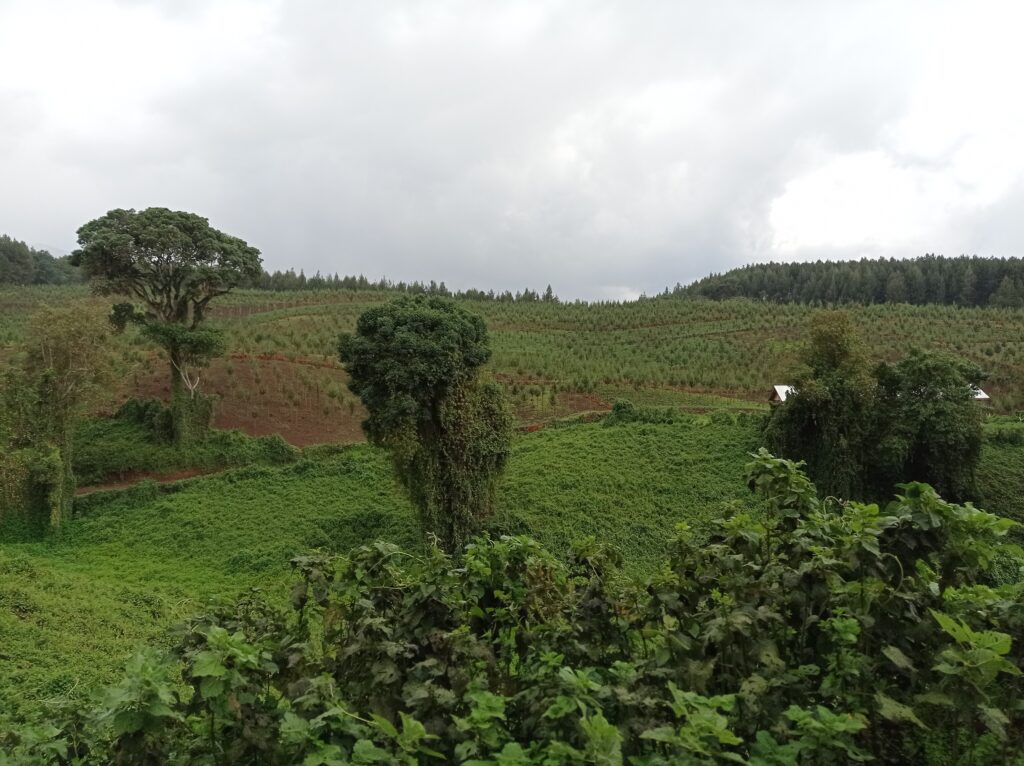




From here on, we had to continued on foot, starting in the early afternoon. It was quite a short hike and we reached Mti Mkubwa Camp in less than 2 hours. We were moving in the forest climate zone throughout. The flair was similar to a deciduous forest in Europe, though a little more overgrown. Also, the species of trees were different and looked somewhat exotic to me.
It started raining a little, but it stopped after half an hour. It was like a warm summer rain in Europe, so not too bad.






We had already seen monkeys during transfer, and we saw more of them along the way. And yet more at the camp, specifically blue monkeys. They were quite cheeky and tried to loot our food supplies, while our porters and the chef were still busy setting up camp for the night and preparing dinner. The monkeys were joined by white-necked ravens, which would be ubiquitous during the whole climb.






Since the Mti Mkubwa Camp is located on the western slopes of Kilimanjaro, we witnessed a beautiful sunset through the forest canopy. We then had a rich dinner (incl. soup, main course, and dessert, but I forgot the details for this particular day) and went to bed early. The first night was colder than I had expected, but no match for our tents and sleeping bags.
Day 2 — Shira Plateau
| GPX: | Morning Route | Afternoon Route |
| Distance: | 8.4km | 7.8km |
| Start – End Altitudes: | 2795m – 3511m (+716m) | 3519m – 3893m (+371m) |
| Climb / Descent*: | 2029m / 1315m | 811m / 438m |
| Time: | 8:00 – 11:42 (3h 42m) | 13:49 – 16:24 (2h 34m) |
We woke up around 7am, packed our stuff and had a nice breakfast. As for the rest of the tour, this included warm porridge, pancakes, toast, honey, jam, eggs, sausages, beans, tea, and coffee.
Today was going to be the second toughest hike, when it comes to distance and gained altitude (only surpassed by the ascent to the summit on day 6). We would be en-route in the morning and in the afternoon, with a generous lunch-break in-between.
So we left camp and continued upwards the gentle slopes of the Kilimanjaro massif towards Shira plateau. This part of the route had many turns and ups and downs, crossing several small valleys. In some places we had a good view of nearby Mount Meru rising from the clouded plains.


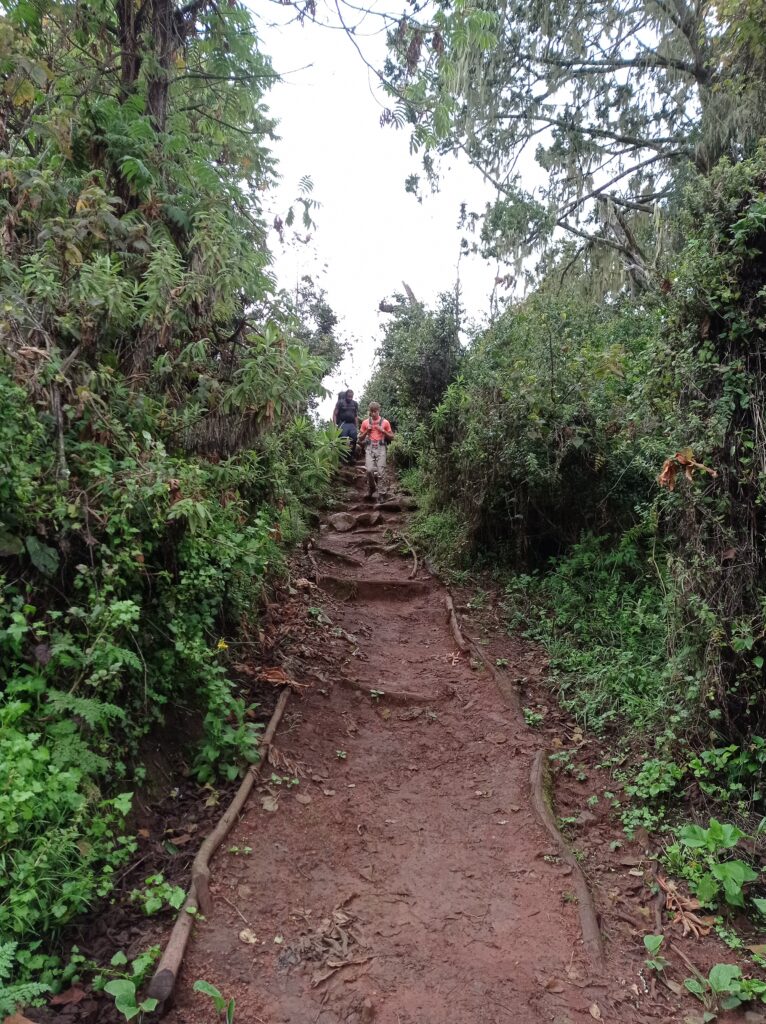
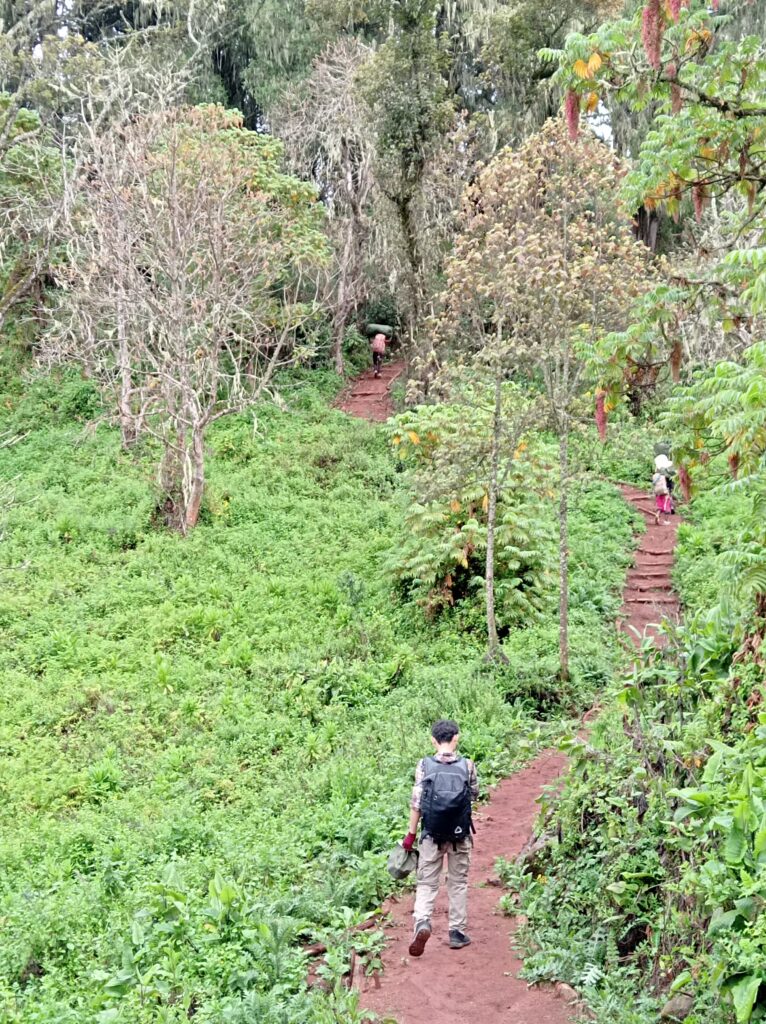


We soon gained enough altitude to leave the forest and enter the moorland climate zone. On average this segment was a little steeper, but it was still an easy walk.









At about half way to Shira plateau it started raining again. We were only about 500m higher than when it had rained the day before. But it was still early in the morning, and there were no more trees providing protection. Thus the rain felt way more unpleasant. (I also got worried, because my wet clothes had not fully dried over night. If it continued raining at this rate, I might soon run out of something dry to wear.)
The rain was quite heavy, too, and the dusty trail soon started to turn into a little creek. The built-in rain drains prevented the worst though, and our sturdy boots allowed us to continue at normal pace. And once again, the rain didn’t last much longer than half an hour.



After the rain I had a closer look at the vegetation. The shape, distribution, and superficial appearance of the shrubs reminded me of the Alps at home. However, inspection of the plants revealed that they were quite different from the familiar mountain pine. I assume that these plants here are only distantly related to our mountain pines, but both have been subject to convergent evolution. Same with the salamanders that I stumbled across later. They are certainly distinct from our alpine salamanders, but they fill a similar niche.
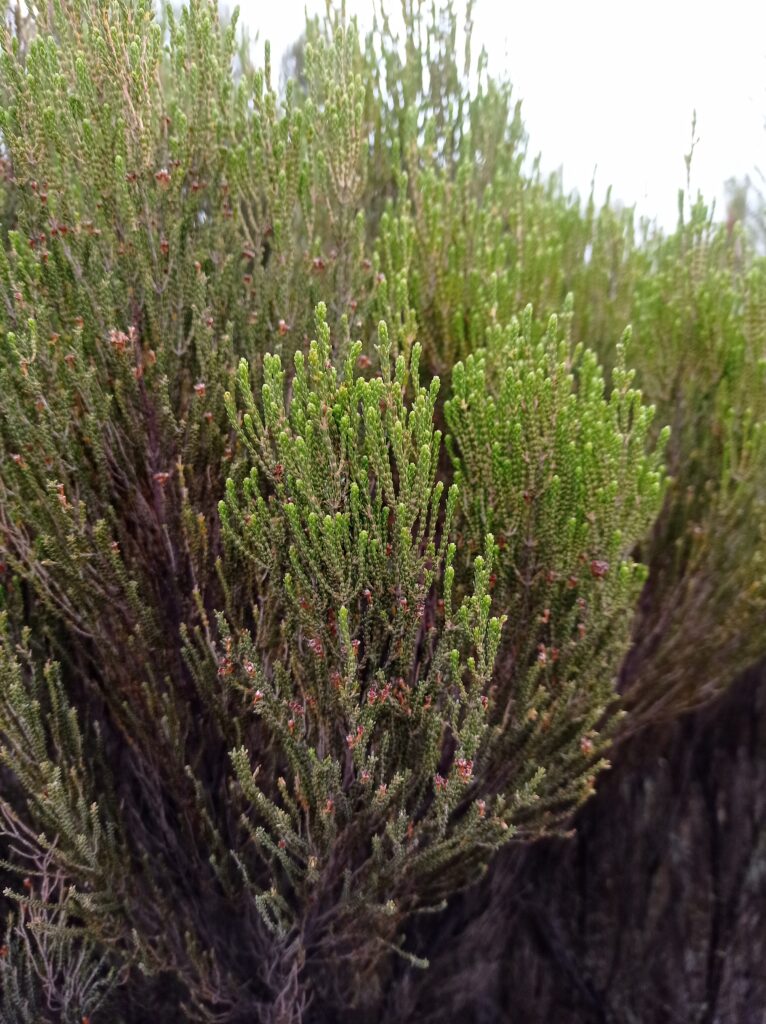


As we continued, we soon reached Shira plateau. The plateau is located in the Shira caldera, which is the remnants of an ancient volcano. At around 1.9 million years ago, Shira imploded and only left the caldera and the plateau. Today the south-western part of the caldera is most pronounced, with it’s highest point at 4005m forming Shira’s summit. Most of the northern part of the caldera has eroded away, while the eastern part has been taken over by Kibo.
We passed the ridge of Shira’s caldera to our right, and entered Shira plateau from the west. The trail leveled here and even had a moderate descent. The shrubs were growing lower and sparser, so we could soon spot Shira 1 Camp (or Moir Camp, according to some maps?) in the distance. We approached it in a fairly strait line, without any further ascent. On a clearer days we might have seen Kibo at the other end of the plateau, but for now it was hidden in the clouds.


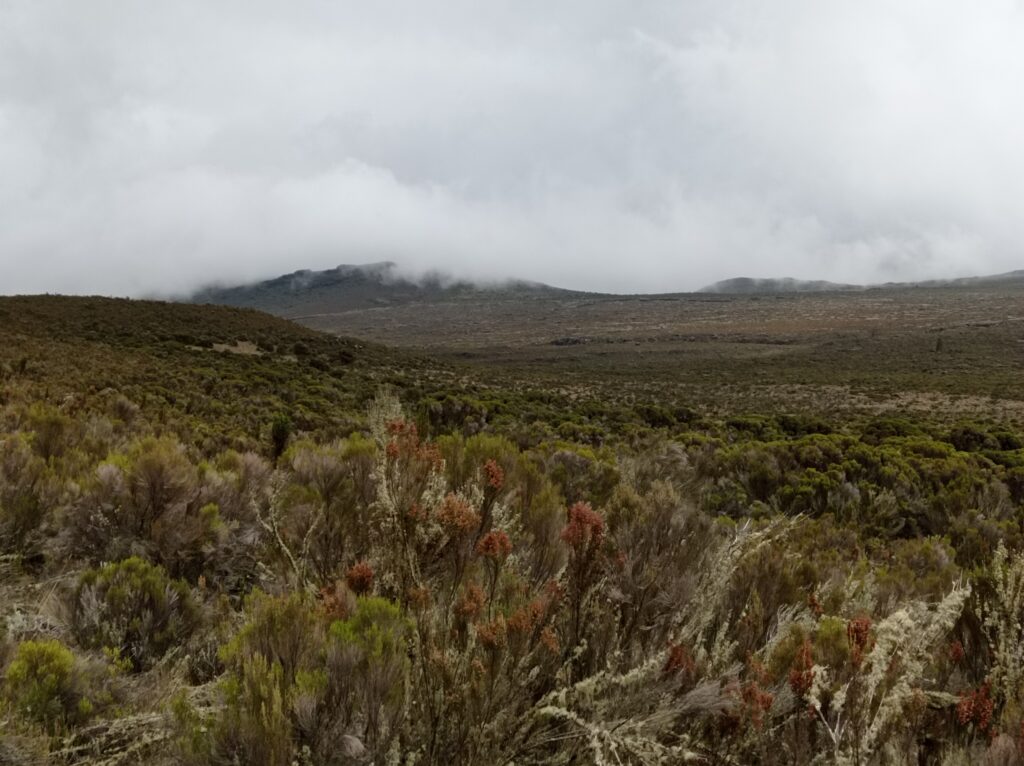



Some climbing parties do the Lemosho Route in 8 days rather than 7 days, and they would stay at Shira 1 Camp over night. For us it was just a lunch break though. It was still partly clouded, but when the sun was coming through, it was quite sharp. That allowed us to dry all our soaked clothes.
Lunch was as opulent as dinner the night before. And frankly all of our meals on this Kilimanjaro climb. So I’ll stop mentioning food from now on.



After lunch, we continued crossing Shira Plateau in south eastern direction. The plateau is not fully level, but slightly rises to the east. The incline was moderate and the landscape was planar, with few obstacles. With clouds overhead, it looked barren and vegetation got sparser the further climbed. We saw smaller shrubs, bushy grasses, and more and more rocks, covered in lichens. The only vaguely tree-shaped plants that we encountered up here were giant groundsels. These look a bit like joshua trees, though they are not closely related. They do not grow tall and are distributed sparsely, but we’d see many more of them during the rest of the hike.
At one point we crossed a gravel road, which leads almost all the way up to our own destination, Shira 2 Camp. However, that road is not open to the general public. Park rangers use it to supply their posts, and for emergency situation. As far as I understood, the road can also be used by mountain bikers, and there are several bike trails across Shira Plateau.

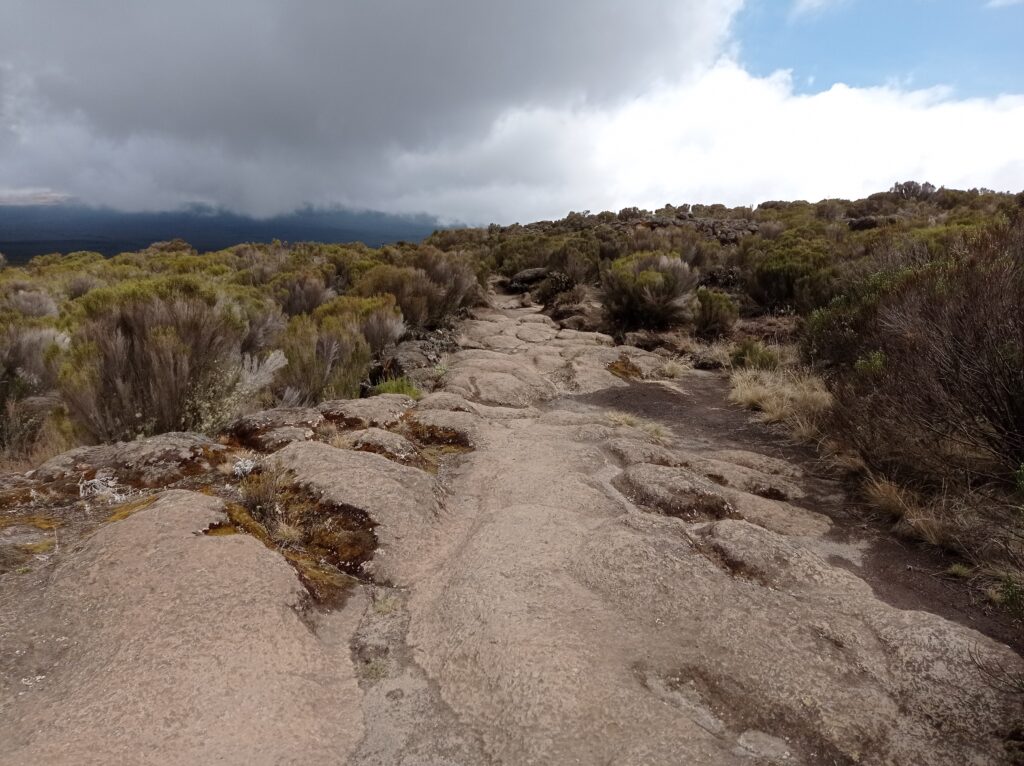


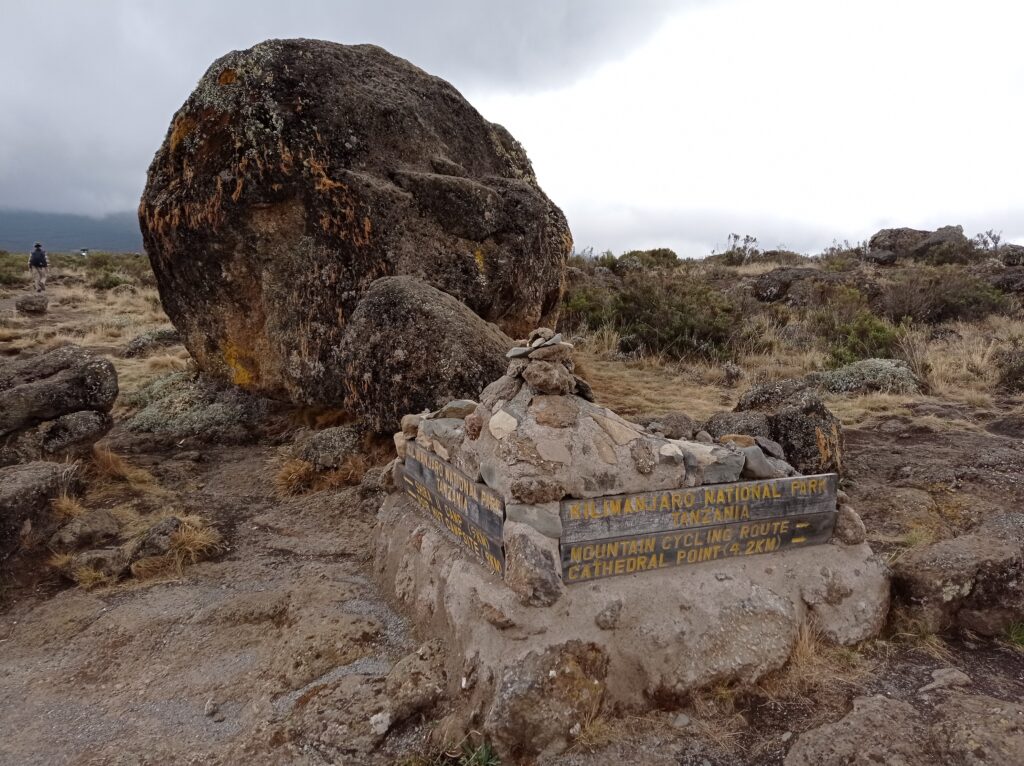




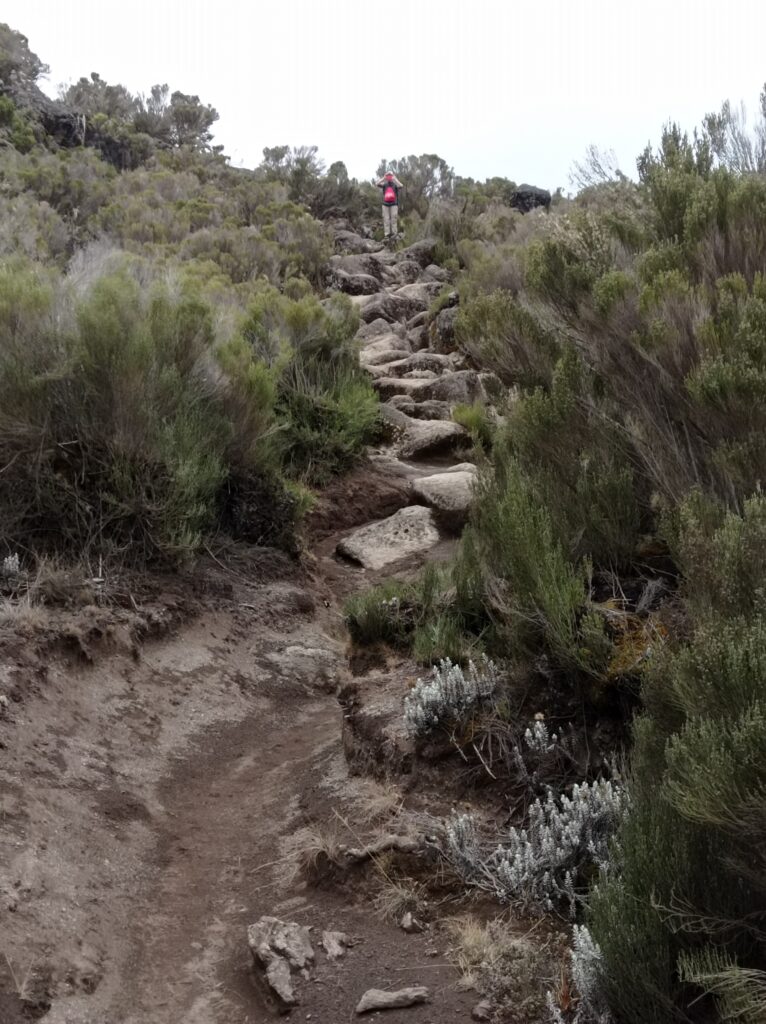

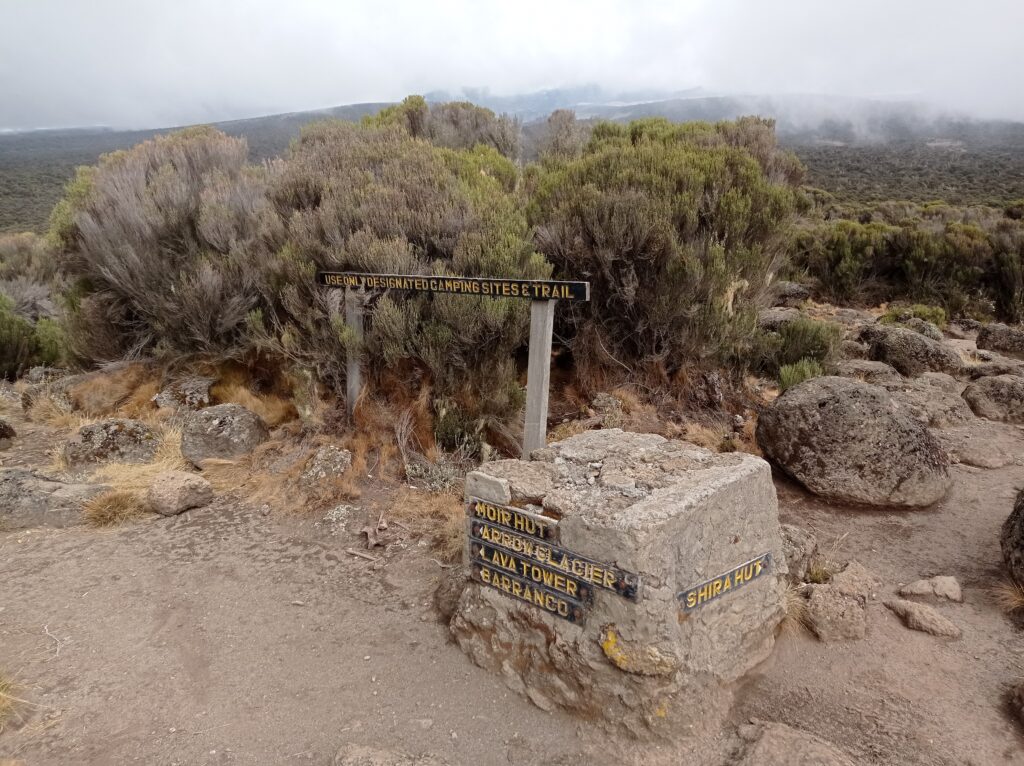
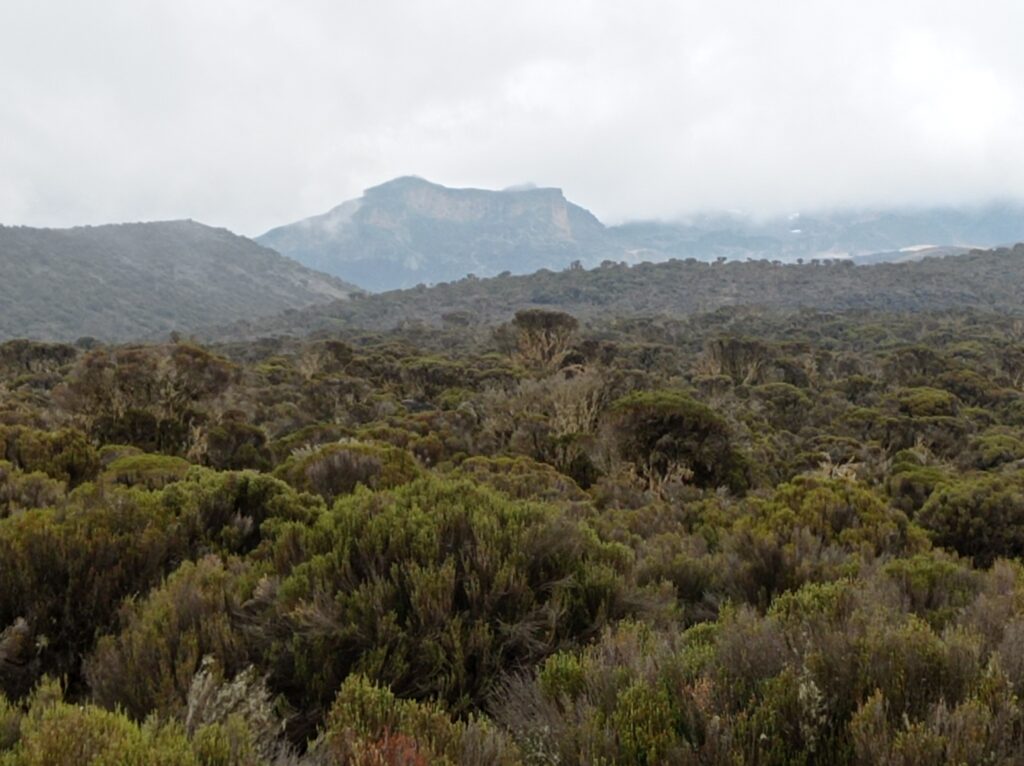


We arrived at Shira 2 Camp, our destination for the day, in the late afternoon. It continued to be clouded, and partially foggy. Most of us put on our winter jackets and hats for the first time. At roughly 3890m, this for now was the highest point that I had ever climbed. After a fairly exhausting day, I had no trouble sleeping at night.






Day 3 — Lava Tower
| GPX: | Morning Route |
| Distance: | 10.6km |
| Start – Max – End Altitudes: | 3900m – 4640m – 3980m (+740m, -660m) |
| Climb / Descent*: | 1527m / 1445m |
| Time: | 8:15 – 11:15 (3h 0m), 11:38 – 13:00 (1h 22m) |
We had heard rain hitting our tents during the night, but we woke up to a beautiful morning. While the plains below us were covered in thick clouds — with Mount Meru peeking out in the distance — there were only few small clouds above us, with lots of sunshine peeking through. This was also the first time that we had a good view of Kibo’s snow-covered crater-rim above us.






The next few days would be all about altitude acclimatization: “walk high, sleep low”. At this point we were still on the west of Kibo. From here, we would circle the mountain along its southern slopes, and finally approach its summit from the south-east. This means there would be a lot of up-and-downs, but we’d always return to an altitude of about 4000m. We’d only be climbing in the morning, just after breakfast, then have lunch and dinner at the next camp, with lots of relaxation time in between.
The goal for today was climbing up to a place called Lava Tower, then climbing down to the next camp. The ascent was only a little steeper than the afternoon before and initially the landscape looked much the same. But soon it would turn more and more barren, dominated by gravel, rocks, and lichens, with only few small sturdy plants. We had reached the alpine desert zone, where we would spend much of the following days.
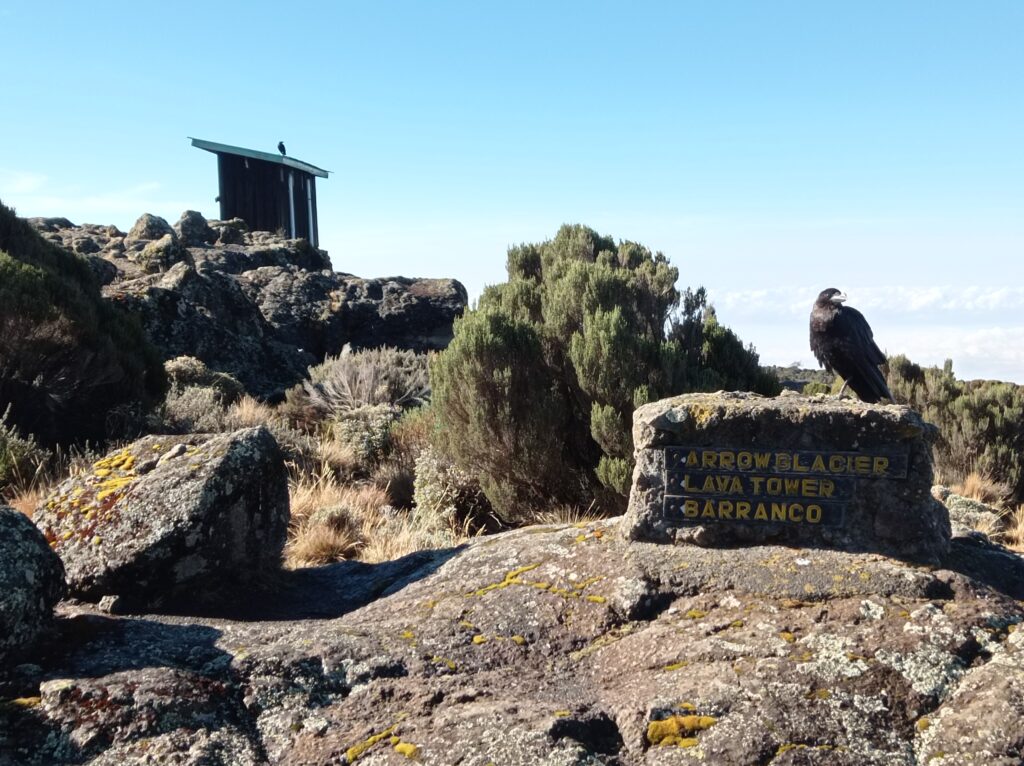


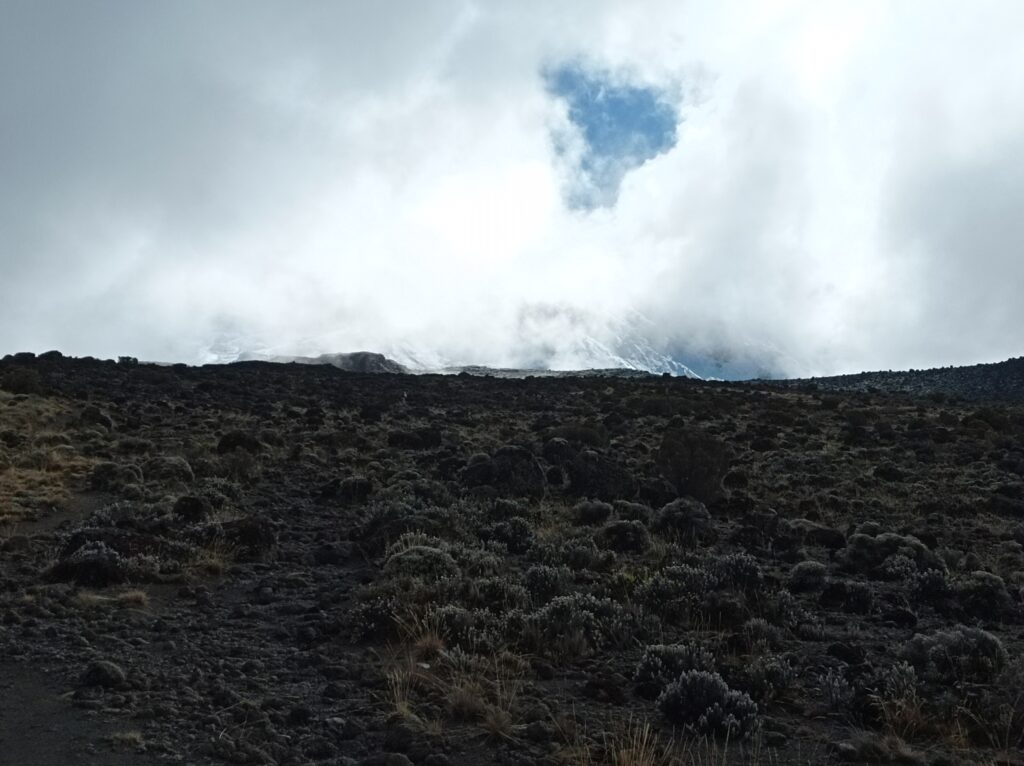





What we had heard as rain the night before, had come down as snow further up. With each of the small ridges that we crossed, we saw more of it. By the time we reached Lava Tower, it was a solid blanket of snow. It was only 5cm deep though, and despite the more cloudy weather up here, it was soft and slowly melting.


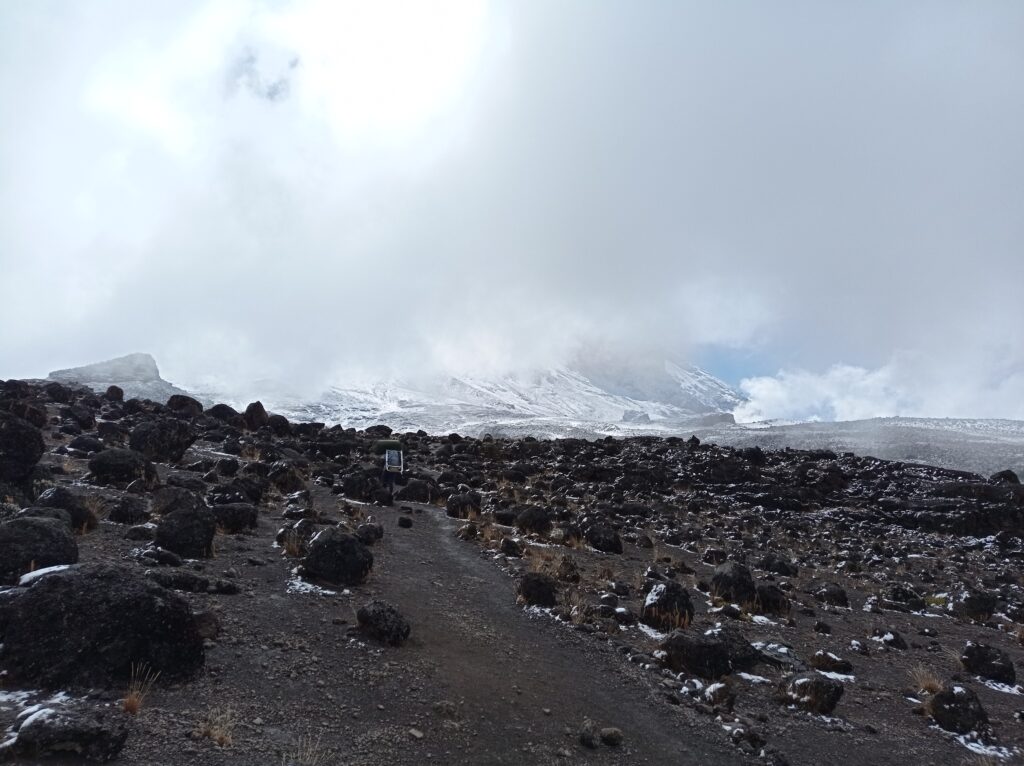

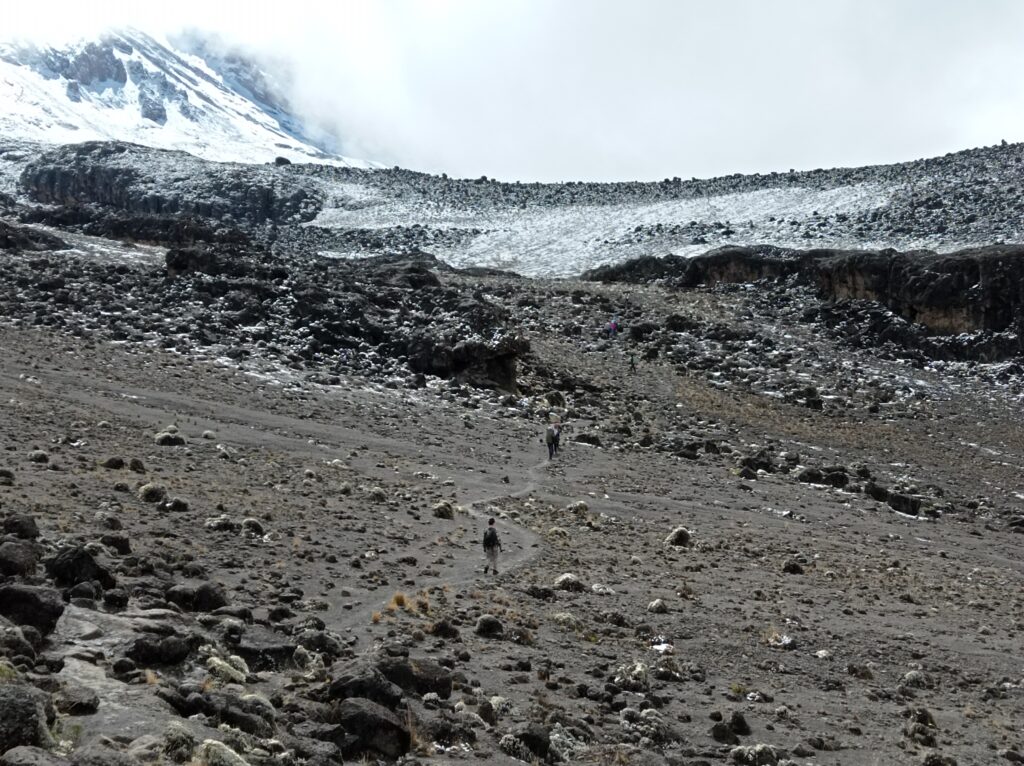


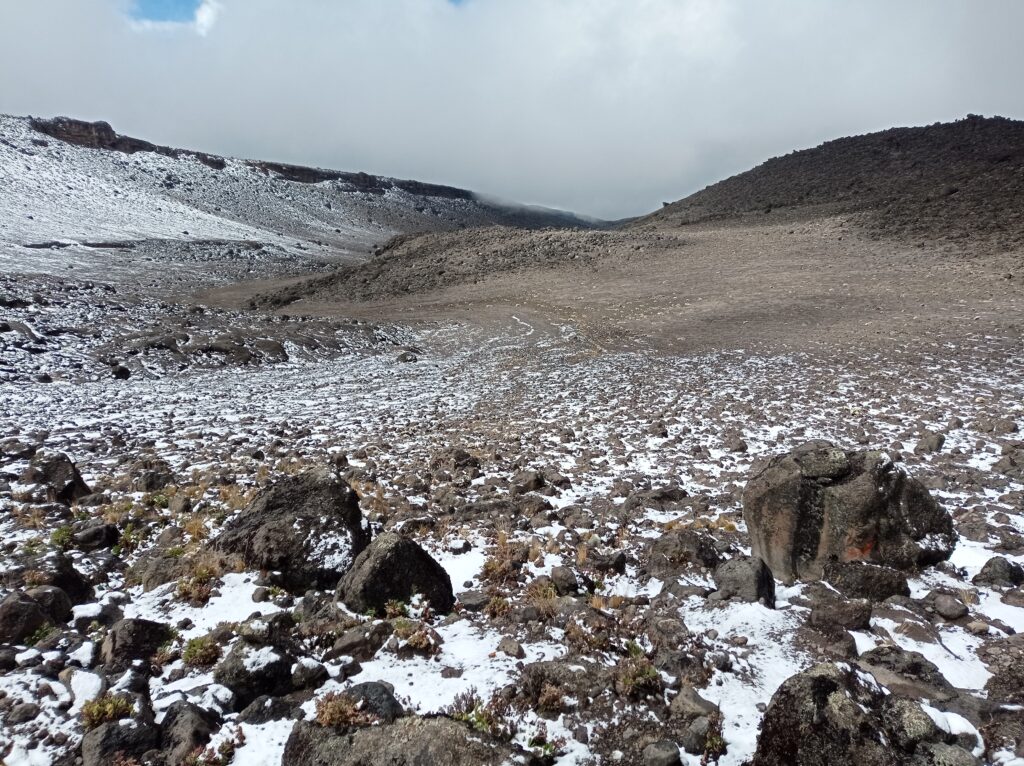




We reached Lava Tower after 3 hours. While Lava Tower is an impressive rock structure, it pales against its surroundings. Nevertheless, a small saddle forms between Lava Tower and Kibo. And today’s route took us straight through that saddle. At just over 4600m, this was my new personal altitude record (like so many during this hike).
We did not camp at the saddle next to Lava Tower, but we had a 20 minutes break, had some snacks, and took lots of photos. I tried to pick a snowball fight, but missed my first shot and got destroyed by our experienced guides.
Shortly after, I noticed those tiny rodents for the first time, whom we would see again during the rest of the trip. I think they were four-striped grass mice. They looked cute with their stripy back, but they were very elusive. I was surprised to see them this far up. Not sure, if they subsist hikers’ food droppings, or on the sparse grasses that were still growing here.
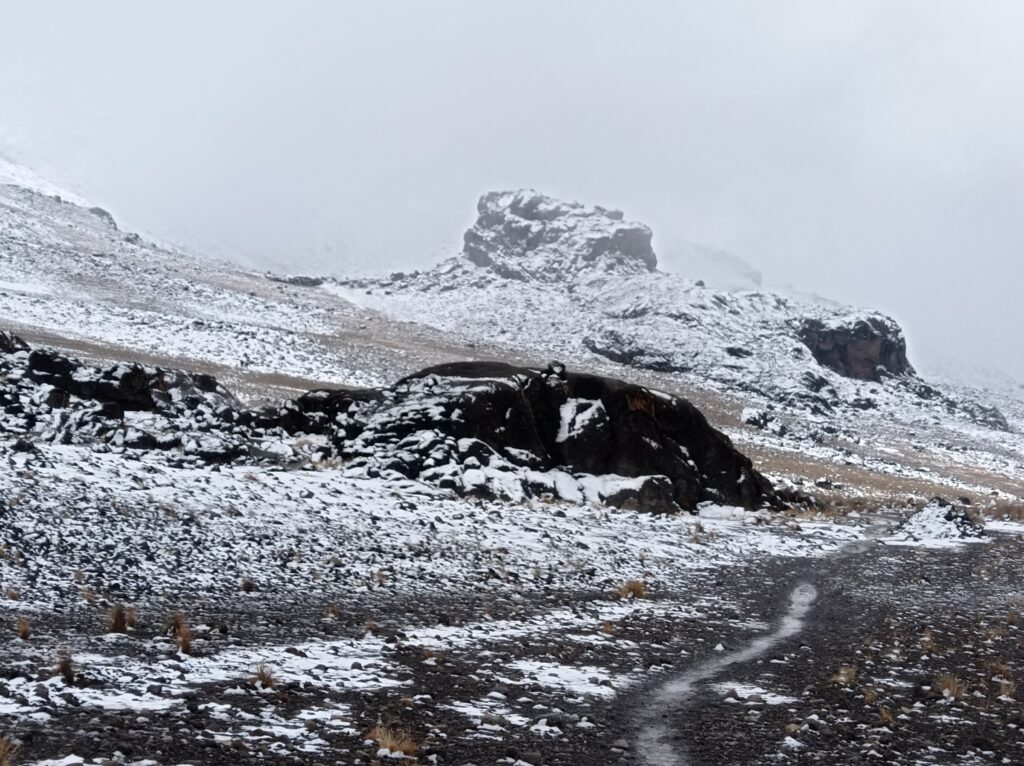
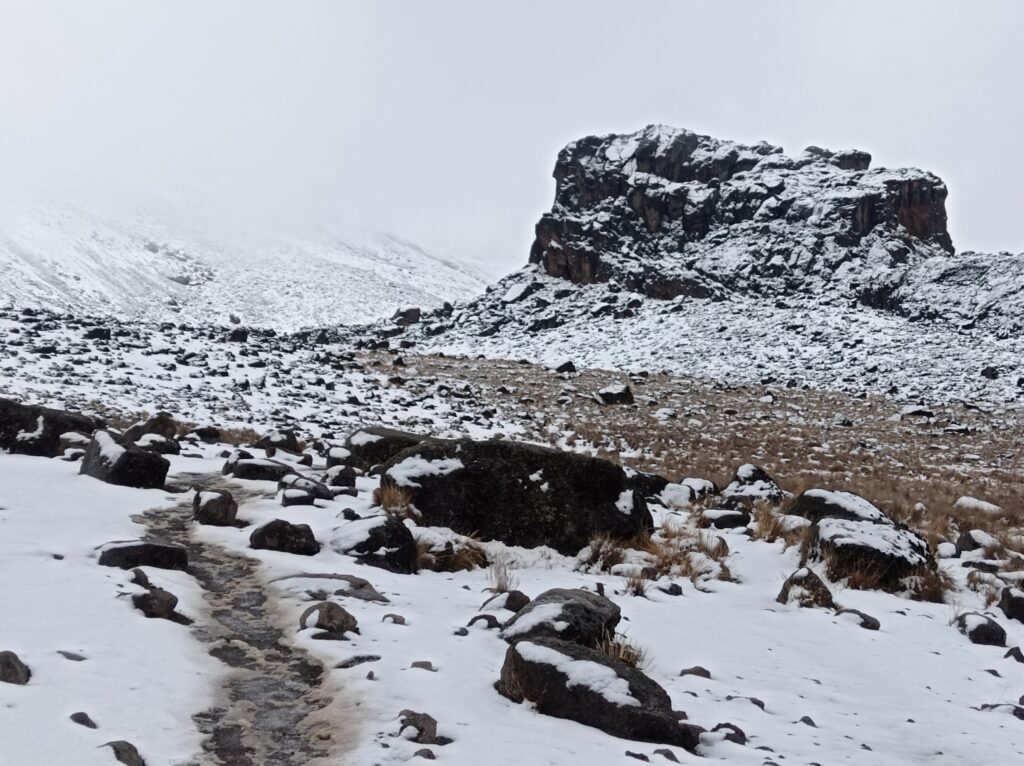




At lava tower, the trail splits: climbers, who want to tackle Kibo from the west, continue upwards to Arrow Glacier Camp. But for us, it was all the way down-hill to Barranco Camp. As snow continued melting, sections of the trail had turned into small creeks. But we reached dryer regions soon, where there was little traces of either snow or water. It remained cloudy and foggy though. That gave a ghostly appearance to those giant groundsels, which we met again shortly before reaching the camp.












Day 4 — Barranco Wall
| GPX: | Morning Route (sorry, missed recording first ~20 mins) |
| Distance: | ~5.2km |
| Start – Extrema – End Altitudes: | 3980m – 4230m – 4054m – 4134m – 3928m – 4054m (+74m altogether) |
| Climb / Descent*: | ~790m / 730m |
| Time: | 8:36 – 11:03 (2h 27m) |
The defining feature of day 4 was Barranco Wall, which we had already seen from Barranco Camp the day before. The camp is located right underneath, and looking upwards to the wall is a little scary. It’s rather steep and found it hard to see where we’d find our way through it. However, Barranco Wall is part of a long ridge, whose other sections look even worse. See the beginning of this pan:
I was kind of nervous about Barranco Wall, because I tend to be afraid of heights. From below, it looked like there might be many exposed points above tall vertical cliffs. In the end, it turned out that it’s not too bad after all. While the wall is steep, it is far from vertical. It rises in a number of terraces and the hiking trail makes good use of these. There’s no place where you’d fall more than a couple of meters. (Of course, in the worst case, you might keep tumbling further down, with a good chance of killing yourself, but somehow my brain processes that as less frightening.)
That said, Barranco Wall was certainly the steepest climb of this Kilimanjaro tour. In some places, I found it easier to use my hands as climbing aids. That made it more fun, but was not strictly necessary. The porters, who only had one free hand, got by without it. In the upper sections, the wall got less steep and we reached its top in about one hour. At just about above 4200m we had reached our highest point for the day — no new altitude records for now.
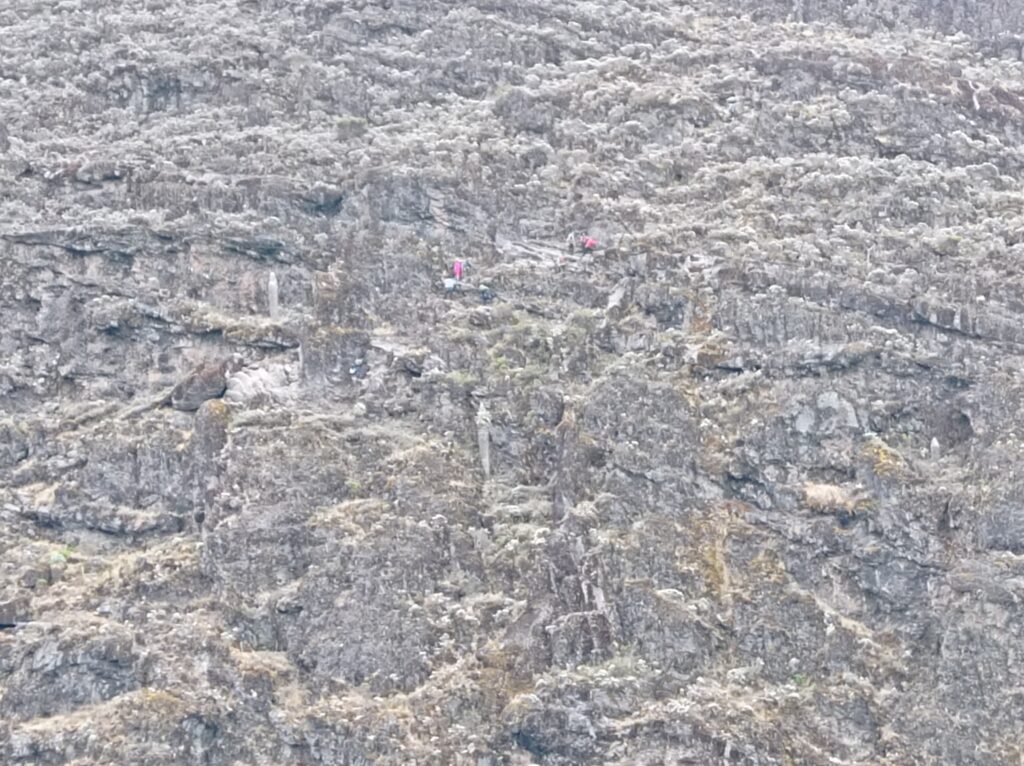
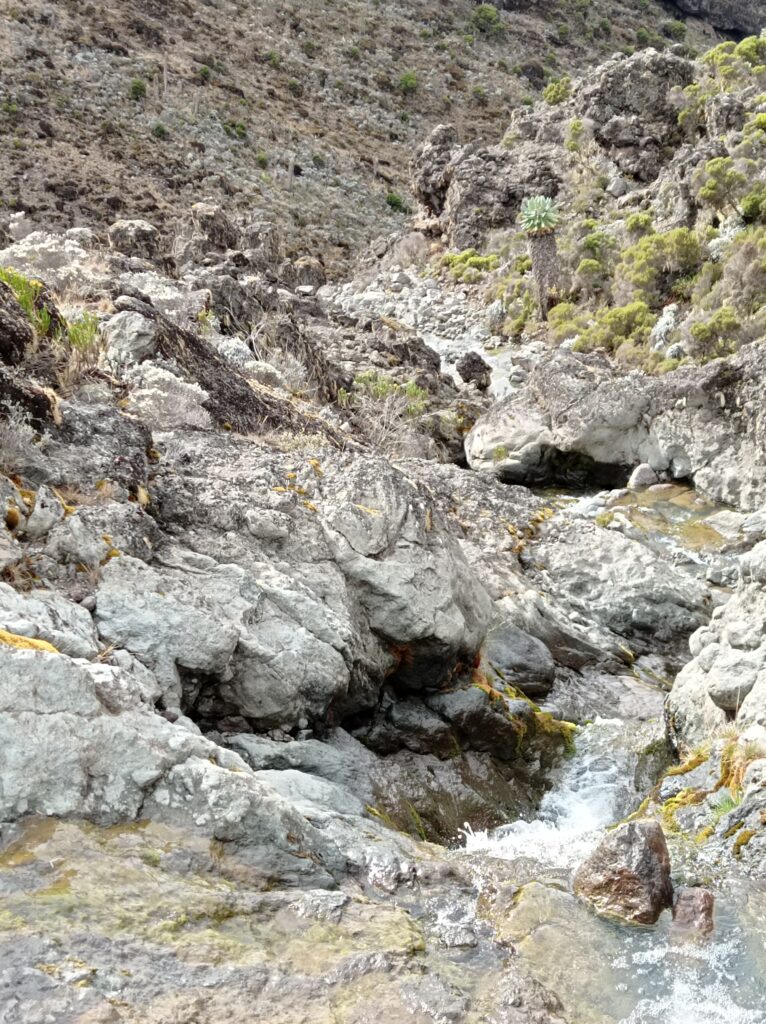


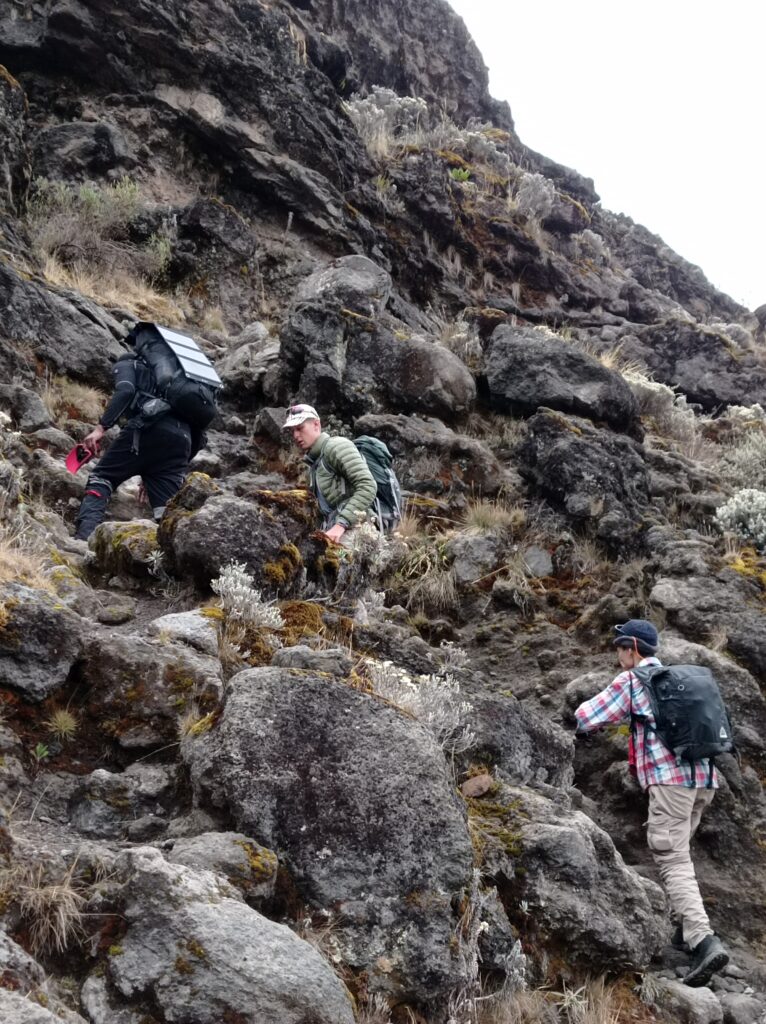



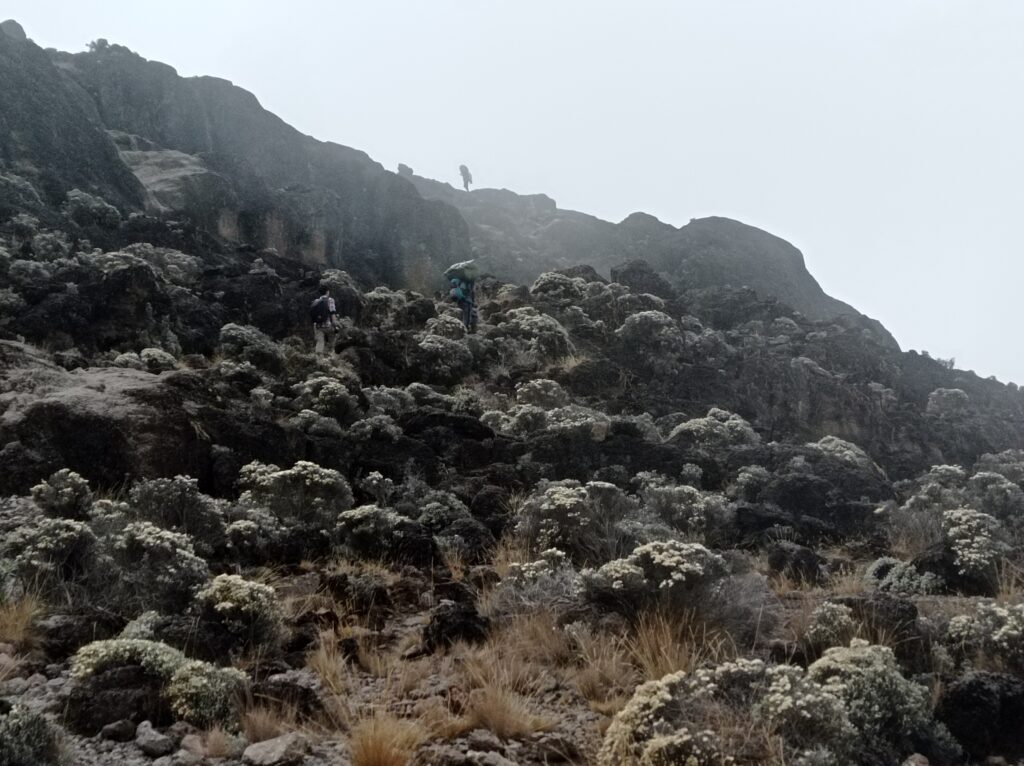


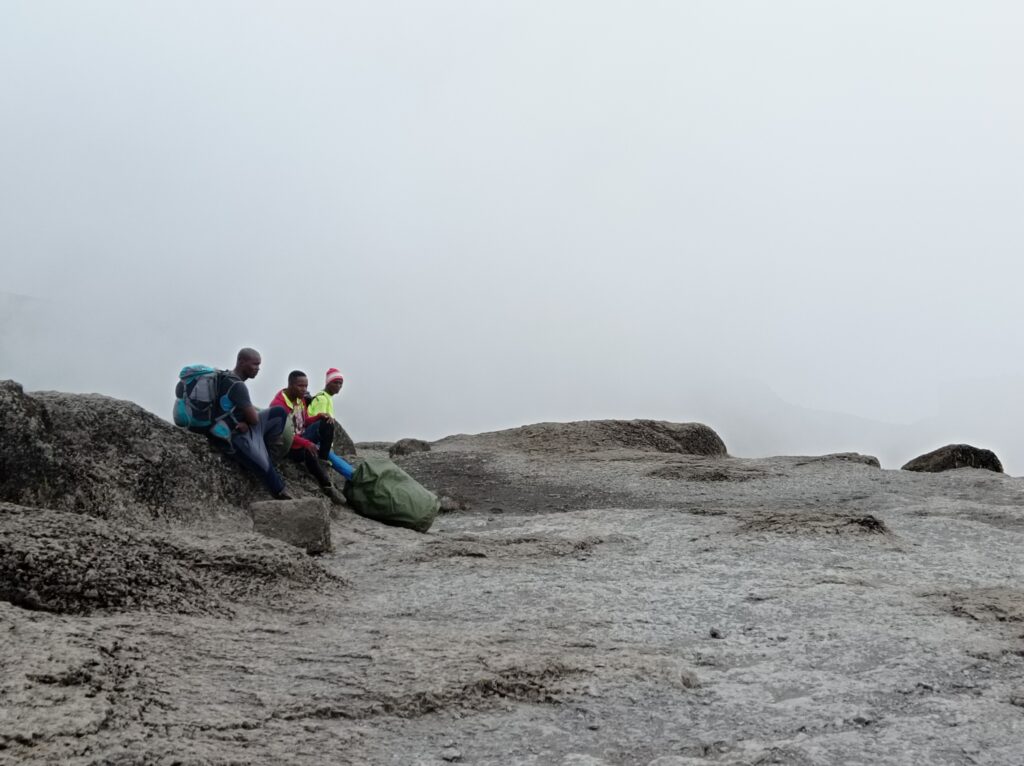
From here it was downhill again, but we still had a few up and downs ahead of. We had to descend into two small valleys and ascend two small ridges before we reached our destination for the day. Luckily the slopes were more moderate from now on. And we were walking just around the boundary between moorland zone and alpine desert zone, enjoying the varied landscape.






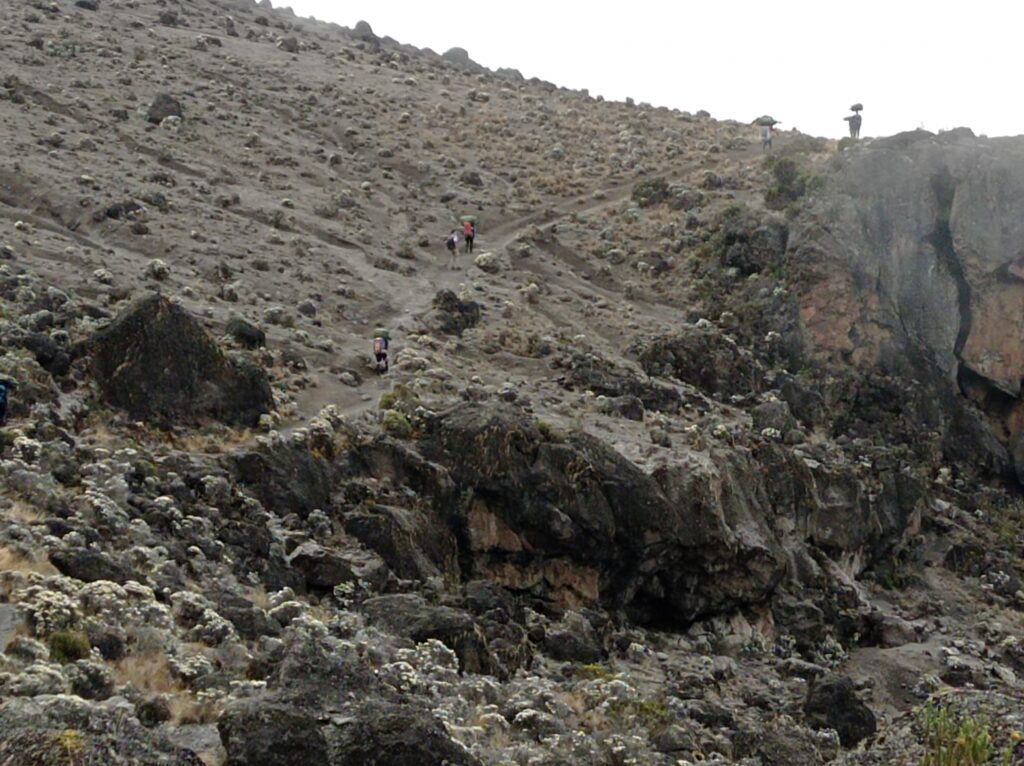



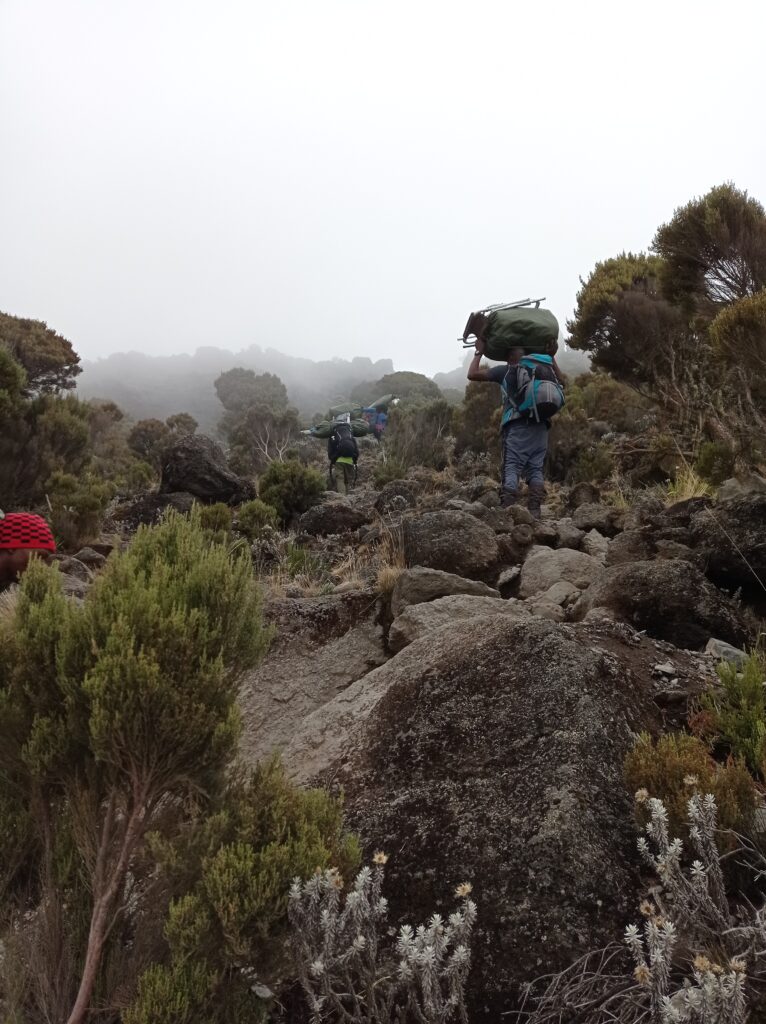

This was one of our shorter hiking days and we reached our destination for the day, Karanga Camp, well before noon. That gave us enough time to explore the area around the camp. The ubiquitous ravens were joined by other birds, which looked like a variety of pigeon, most likely dusky turtle doves. And I found more of the four-striped grass mice that I had first seen at Lava Tower.






I used the afternoon to talk to some of the other hiking parties on the mountain. Some of them had been hiking alongside us for the past few days, but we had not found much time exchange our experiences yet. They were all very happy with the hike so far — especially with their crews — and excited for Kibo’s summit.
So far this day had been dry, but rather foggy. In the late afternoon a little more sunshine pierced the clouds, once again giving us scenic views of the surroundings.



Day 5 — Ice Camp
| GPX: | Morning Route |
| Distance: | 3.7km |
| Start – End Altitudes: | 4045m – 4670m (+625m) |
| Climb / Descent*: | 881m / 260m |
| Time: | 8:48 – 10:51 (2h 4m) |
The morning greeted us with a blue sky and all clouds below us. Also, clear views of Kibo above us, and Mount Meru in the distance.



Today was another short hike, even shorter than the days before. However, no more of that up-and-down altitude-acclimatization nonsense. No, today would be entirely uphill, bringing us closer to the top of Kilimanjaro. The incline was moderate, but all the walking of the past days began wearing on me. Or maybe it was the altitude?
Even though clouds started to form around us, indicating some humidity, the landscape looked yet more arid. A solar-powered communications relay station (presumably) almost looked like a Mars-rover (ignoring blue sky, clouds, and low-tech appearance).



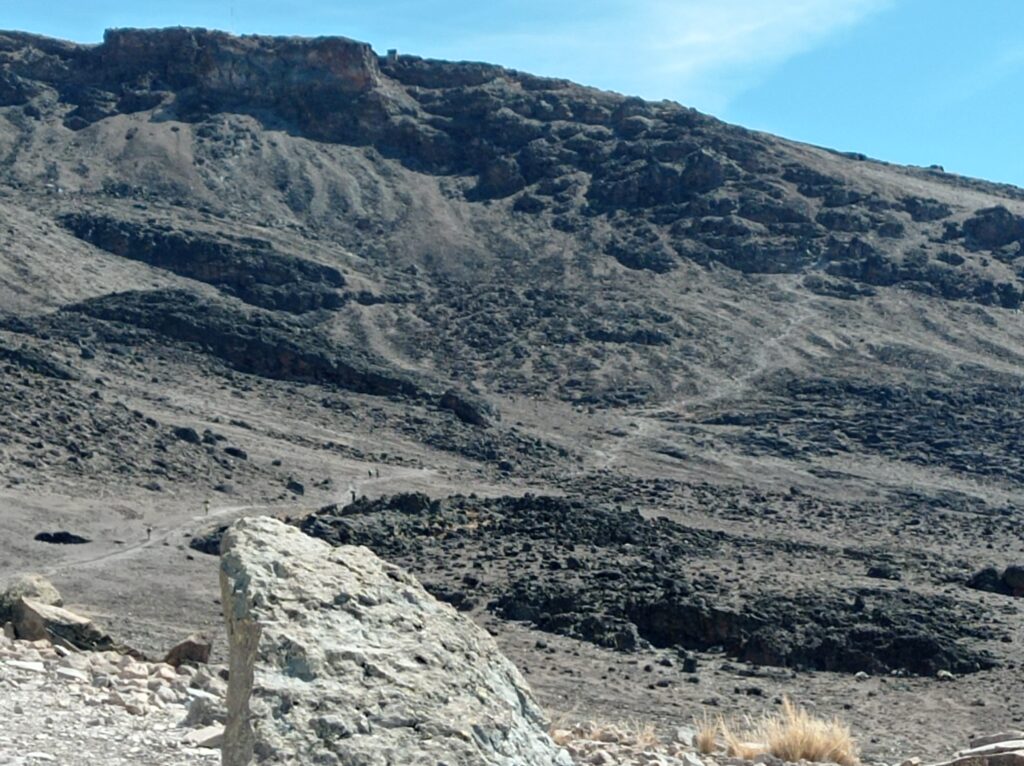

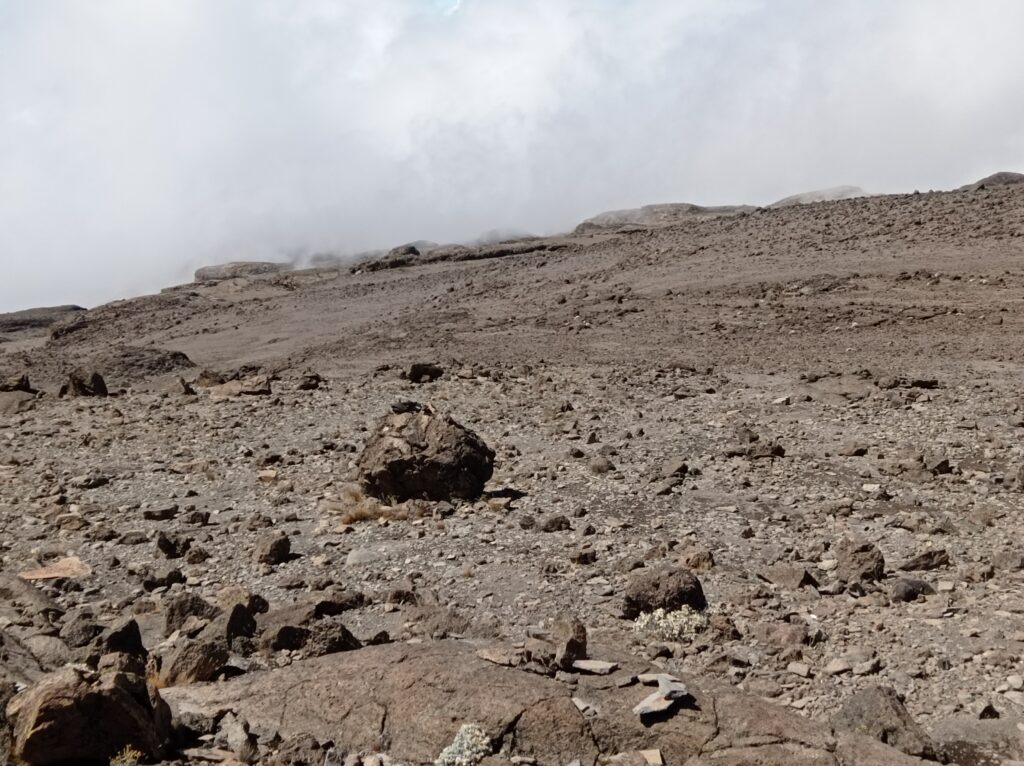



We reached Barafu Camp after about two hours. “Barafu” means “Ice” in Kiswahili, and it’s easy to imagine why they picked that name. There wasn’t much ice or snow at the camp when we arrived, but there wasn’t much of anything else either. Only rocks and lichens here. But when weather allows, there’s a good view of some of Kibo’s icy glaciers.
Barafu Camp is located on a pronounced ridge, and reaching that ridge we could see Kilimanjaro’s eastern peak for the first time. It’s called Mawenzi and is 5149m high. Though smaller than Kibo, Mawenzi’s peak is more pointy and more rocky than the other two Kilimanjaro summits. An impressive rolling saddle plateau forms between Kibo and Mawenzi at about 4400m.






At almost 4700m, Barafu Camp was yet another personal altitude record for me (slightly higher than Lava Tower). It was our last camp before attempting to reach Kibo’s summit. Like most climbing parties, we would start that endeavor in the middle of the night. We’d climb up to the summit, then down to Barafu Camp, then to a lower camp.
So we had a big day ahead of us! That’s why we tried to catch some sleep as early as possible. I went to bed soon after lunch, and I told our crew not to wake me up for dinner. I thought that sleep would be more important for me than food. In the end I happened to wake up around dinner time, so I had a few bites after all. I went back to bed right after, and had not trouble falling asleep again.
Day 6 — The Summit
| GPX: | Night Route | Morning Route | Afternoon Route |
| Distance: | 6.2km | 5.2km | 7.5km |
| Start – End Altitudes: | 4660m – 5895m (+1235m) | 5895m – 4670m (-1225m) | 4670m – 3088m (-1582m) |
| Climb / Descent*: | 2209m / 984m | 201m / 1428m | 425m / 2069m |
| Time: | 0:06 – 6:46 (6h 40m) | 6:46 – 8:45 (1h 59m) | 11:54 – 14:49 (2h 55m) |
I’ll count this as day 6, although it started before midnight. After our guides had woken us up, we put on all our clothing layers, including winter jackets and (for the first time) winter pants. It had started snowing a couple of hours ago, and our tents were already covered in a thin white layer. However, it was cold and dry, and the snow was much preferable to the bursts of rain that we had experienced a before.
We started the day with some tea and snacks at camp, but we got going at around midnight. Obviously it was dark outside and we all had to wear headlights. For the summit ascent, the tourist-to-crew ratio was one-to-one. We tourists were joined by our two guides and an experienced porter.
While we had been flexible about pole pole in the days before, this time we took it seriously. Our head guide took the lead and set a slow but consistent pace. I walked right after him — being the slowest in our group, I feared that I might fall behind otherwise.
Altogether we approached Kibo from the south-east, in a fairly straight line. The very first segment was a little rocky, and slippery underneath the soft snow. Then it was mostly gravel as the trail wound up Kibo’s slopes in serpentines. The snow cover wasn’t deep enough to be much of an impediment — besides we had one other climbing party ahead of us, whose steps we could follow.
We took short breaks from time to time. The guides had brought hot tea for us, and even small snacks. But we never rested too long, because motion protected us from the freezing weather.



The voyage upward seemed endless and dull. From time to time I pointed my light upwards, hoping to see the crater rim; or the slope getting less steep; or at least some interesting feature, like a ridge. But there wasn’t any of that and I knew that we still had a long way ahead of us.
I got very exhausted and at times I thought that I could faint. I was reminding myself to drop into a favorable direction, should that happen. Luckily it did not happen.
At some point it must have stopped snowing, but I do not remember when. As the sky above us cleared up, we could eventually see the stars.
Somehow, after five and a half hours, we reached Kibo’s crater rim. This was at a place called Stella Point, at about 5750 meters high. It had started to dawn by now, and we could see the sun rising behind us, above Mawenzi to the east. As usually, the plains below us were covered in thick clouds.



At Stella Point, we got a first glimpse of Kibo’s volcanic crater. It isn’t very deep, but it is a lot waster than I had expected. By now, there was a thick blanket of snow all around us and covering the whole crater plateau. The landscape reminded me of a high-mountain pass or plateau in the European Alps in winter.
We could also see the highest point of the crater rim from here, the summit of Kilimanjaro. It was just about 1 kilometer to the west and still about 150 meters above us. So we turned left and started traversing the southern crater rim in clock-wise direction, towards the summit. The rest of our ascent was a lot less steep than our climb to the crater rim. Surprisingly, there was almost no wind up here and the rising sun started compensating for the freezing air.
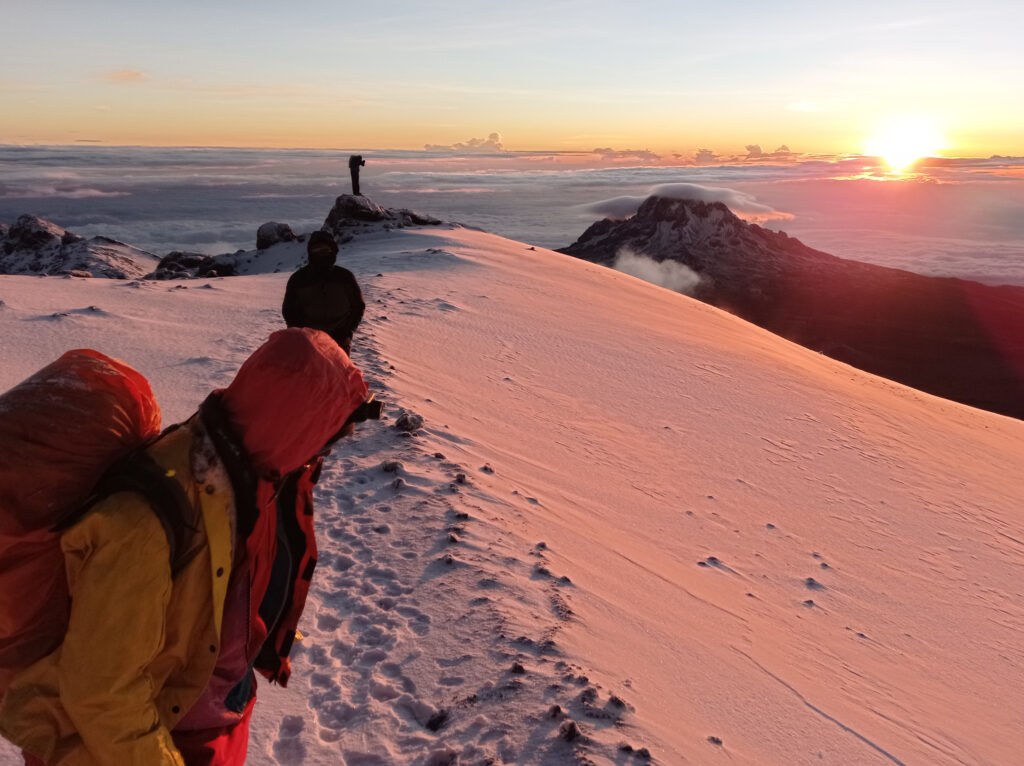
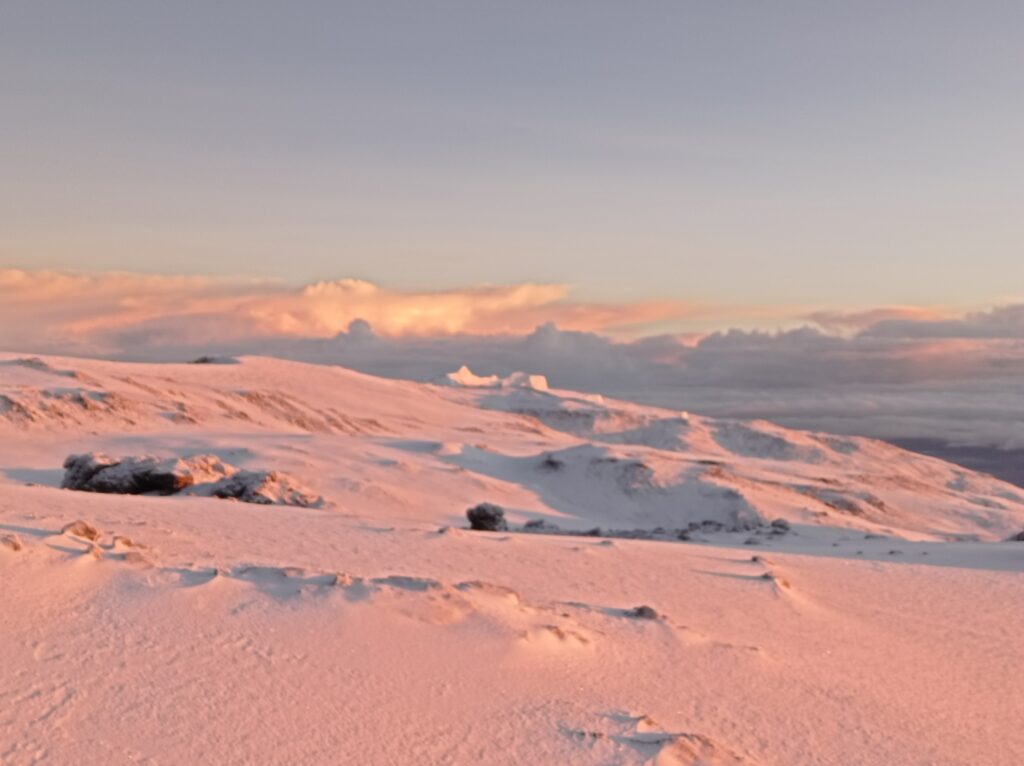
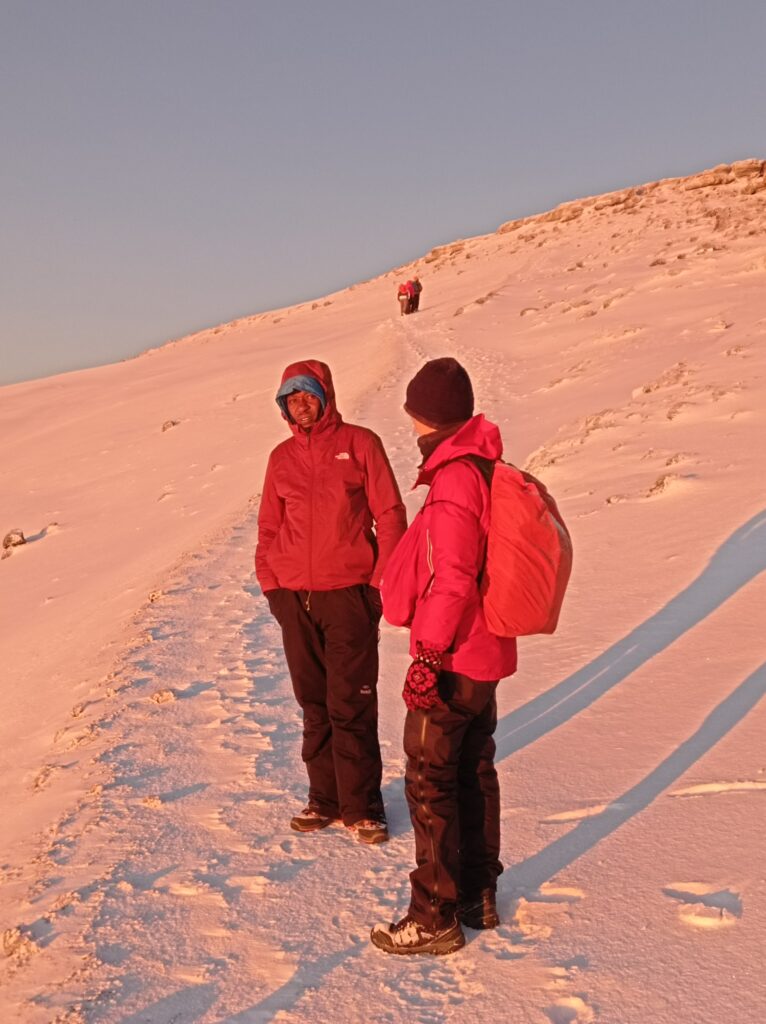
After an hour on the crater rim, we finally reached Uhuru Peak (Uhuru means freedom in Kiswahili). At 5895m, this is the summit of Kibo, the highest point of the Kilimanjaro massif and of Africa. Another personal altitude record, and this one will stick for a while.
I do not remember any signs of altitude sickness, other than extreme fatigue. As can be seen on the photos, I was totally destroyed by now. I don’t think that I could have climbed much higher. But in this moment, joy prevailed. And the knowledge that getting down the mountain will be a much easier task.

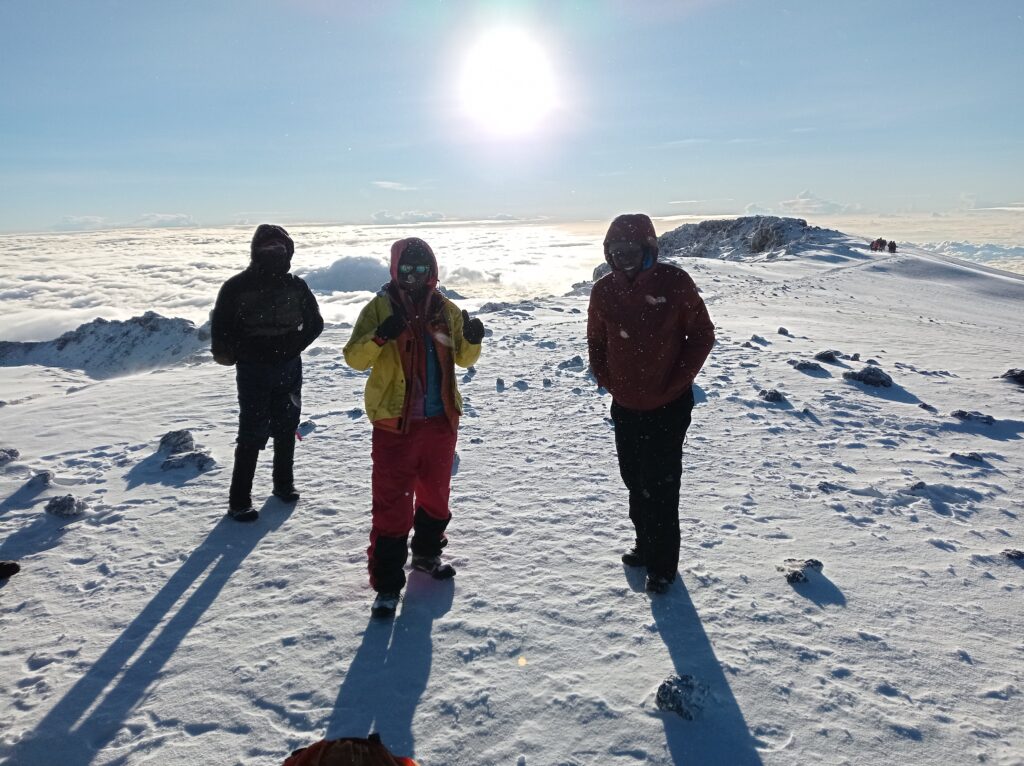
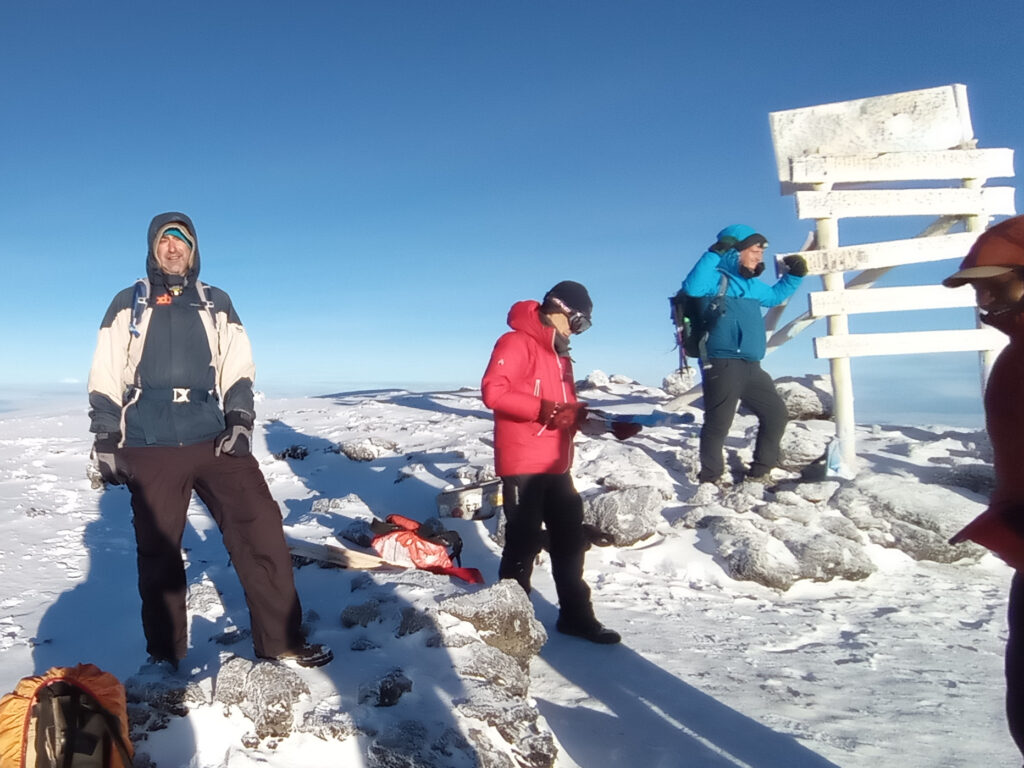






The crater rim at Uhuru Peak is very wide, appearing more like the top of a mellow hill. From here we had a good view of Kibo’s crater to the north and its outside slopes to the south. There where several small glaciers on both sides, all with a vertical wall at their upper edge, unlike anything that I had seen before. In the distance we could once again see Mount Meru peeking out from the clouds.
We weren’t the only climbers today. A small group had reached the summit before us, others joined us soon. But it wasn’t crowded either, I’d estimate that only about 30 people visited the summit that day. We all enjoyed the views and took photos. This meant taking off my thick gloves, and despite all the sunshine my hands would soon begin to freeze. That’s why I have so little footage of the summit.
Normally, I like to linger on summits. Sit down, eat a snack, have a drink, and maybe a cigarette. Enjoy the landscape. But there was nowhere to sit down and it was still freezing cold. Besides, we had a long descent ahead of us. That’s why none of us climbers stayed at Kibo’s summit for more than fifteen minutes. Instead, we headed back down, following the same route along the crater rim that we had climbed up.








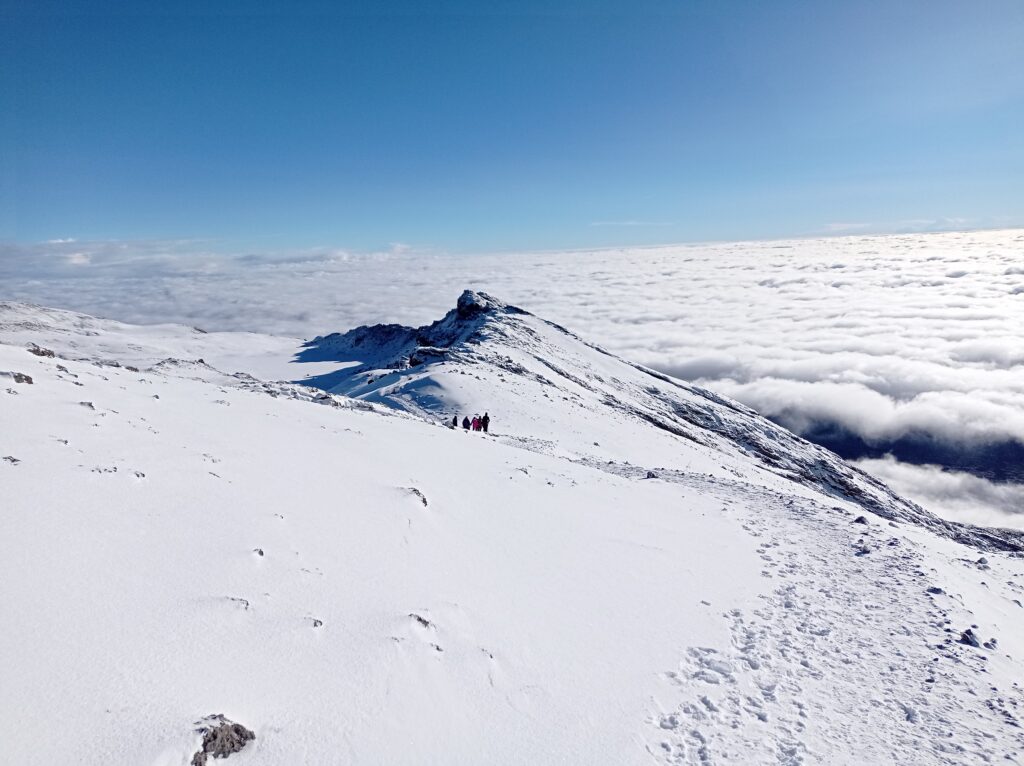
At Stella Point, we entered the steep slopes of Kibo once again. We did not follow the zig-zag trail that we had used for ascent though. Instead, we tried to find more open fields of gravel and slide down on them as fast as possible. Unfortunately, that did not work quite as well as on some other volcanoes. Our way was blocked by different sizes of boulders. So we could not simply let gravity pull us down, but we constantly had to change course and evade obstacles. The snow that was still lying around made it even harder to find the path of least resistance.
That said, walking downhill was a piece of cake, compared to our uphill struggles earlier this morning. We reached Barafu Camp less than 2 hours after we had left the summit.
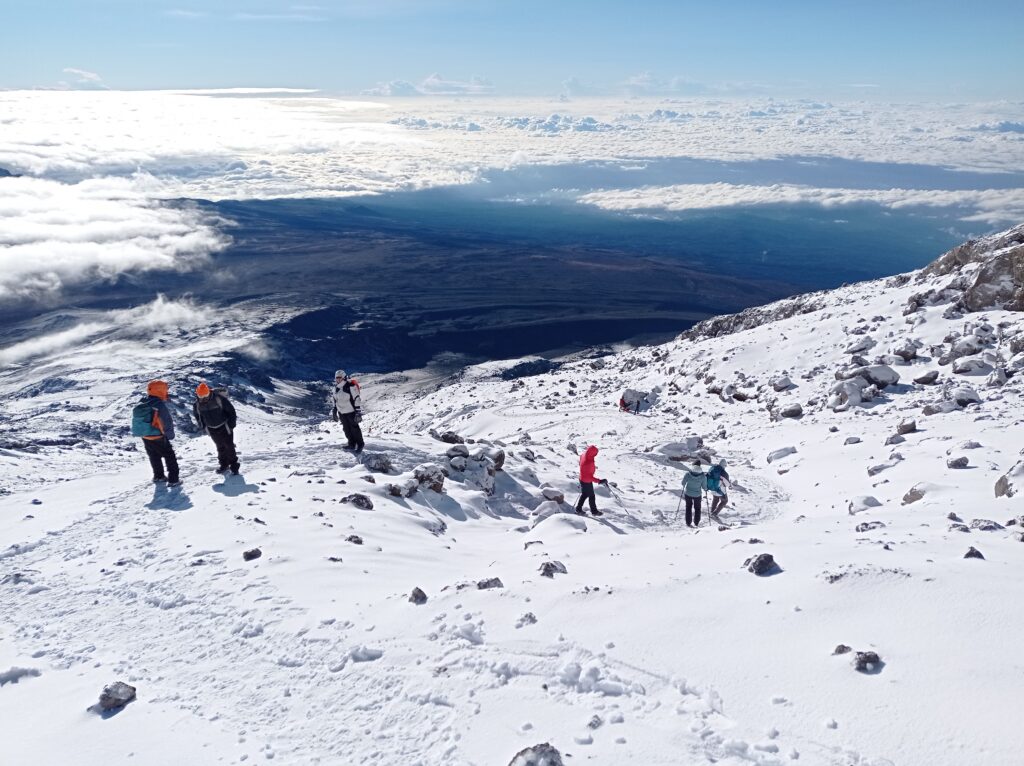








It was still morning and our day was not over yet. First we had a nice breakfast and tried to relax. I lay down in my tent and tried to catch some more sleep. But I was way too psyched to sleep, and by the time I had calmed down, it was time for lunch.
After lunch, we started hiking again. After all, we were still at an altitude of 4670 meters now. And we wanted to get to a lower camp, to avoid altitude related problems. It was an easy trail, all down-hill and moderately steep. But after all the uphill climbing and downhill running this day I was super exhausted. I just didn’t had the energy anymore to go downhill at a decent pace.
The clouds had moved upwards by now and it was all foggy around us. We passed a pile of one-wheeled stretchers, which are allegedly used to get altitude sickness victims down the mountain. They looked surreal with the fog and the desert wasteland around them. The landscape would change rapidly though. We met the first moorland shrubs a little above a place called High Camp. However, our destination was yet lower, just at the upper boundary of the forest zone.
Unfortunately, it started raining before we could reach that destination, Mweka Camp. Once we arrived, in the early afternoon, I hid away inside my tent as quickly as possible. We had walked over 1200 meters up and 2800 meters down that day. I fell asleep fast and I did not wake up until the next morning.

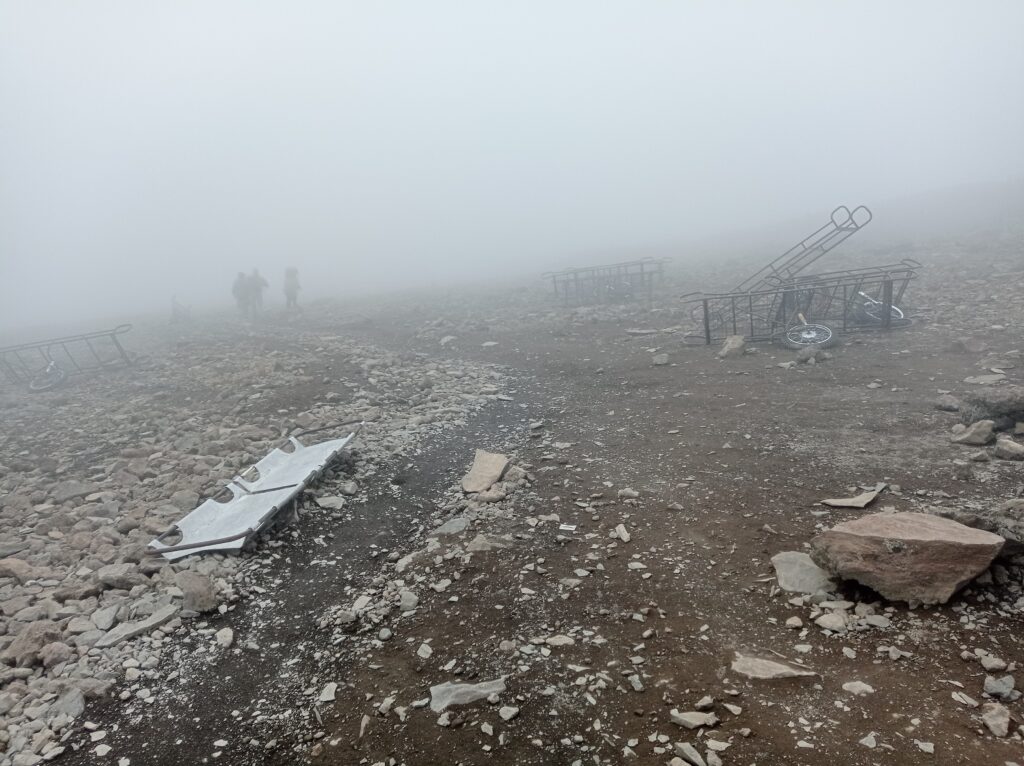
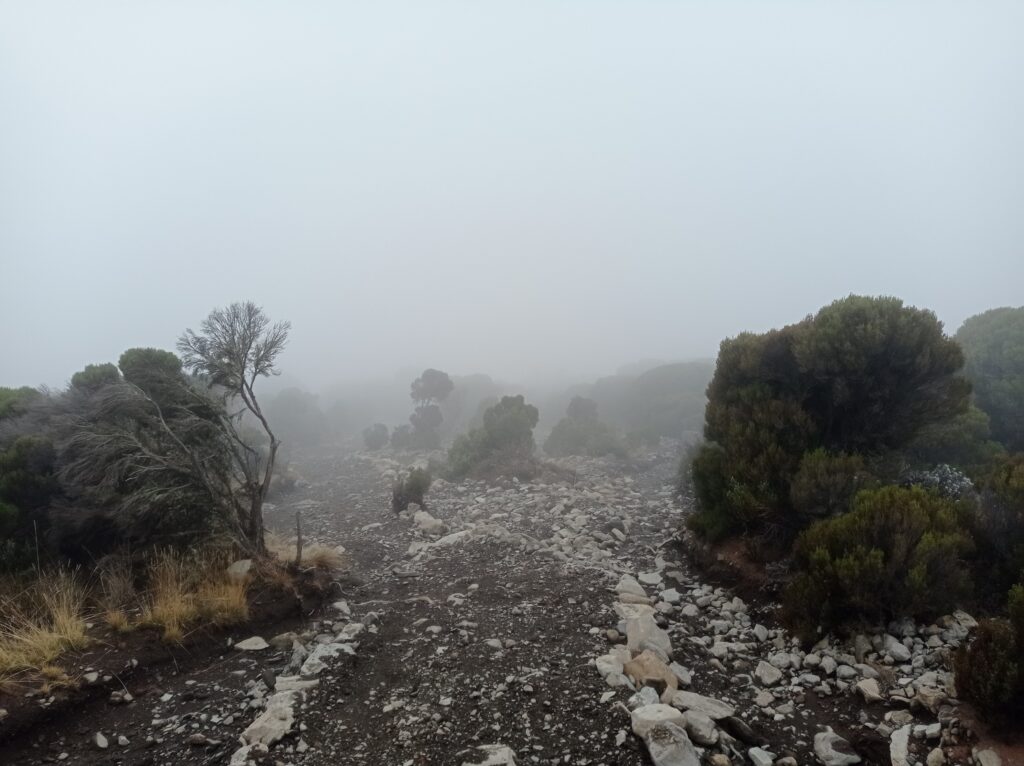

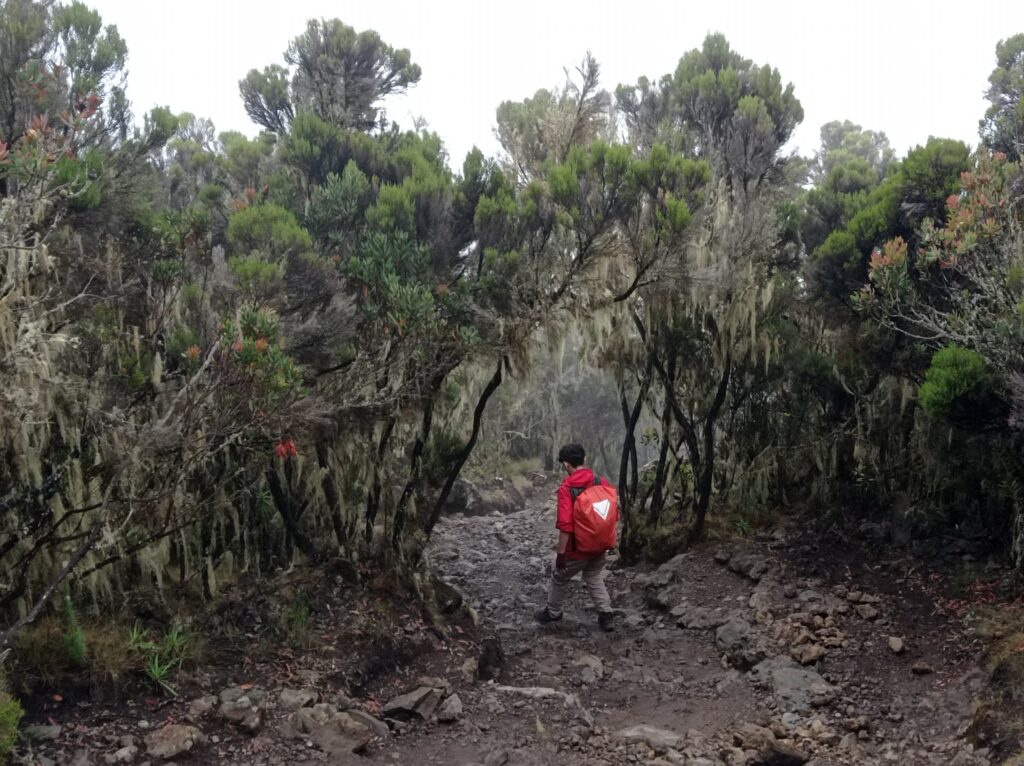

Day 7 — Goodbye Kilimanjaro
| GPX: | Morning Route |
| Distance: | 9.2km |
| Start – End Altitudes: | 3086m – 1684m (-1402m) |
| Climb / Descent*: | 969m / 2412m |
| Time: | 8:16 – 10:33 (2h 17m) |
Our last day on the mountain was just a formality. Luckily, it had stopped raining and it would remain dry for the rest of the day. All that we had to do was hiking down to Mweka Gate.
It was all forests around us, but I was still too exhausted to give much attention to our surroundings. Not even to the monkeys, which we heard howling somewhere in the distance.

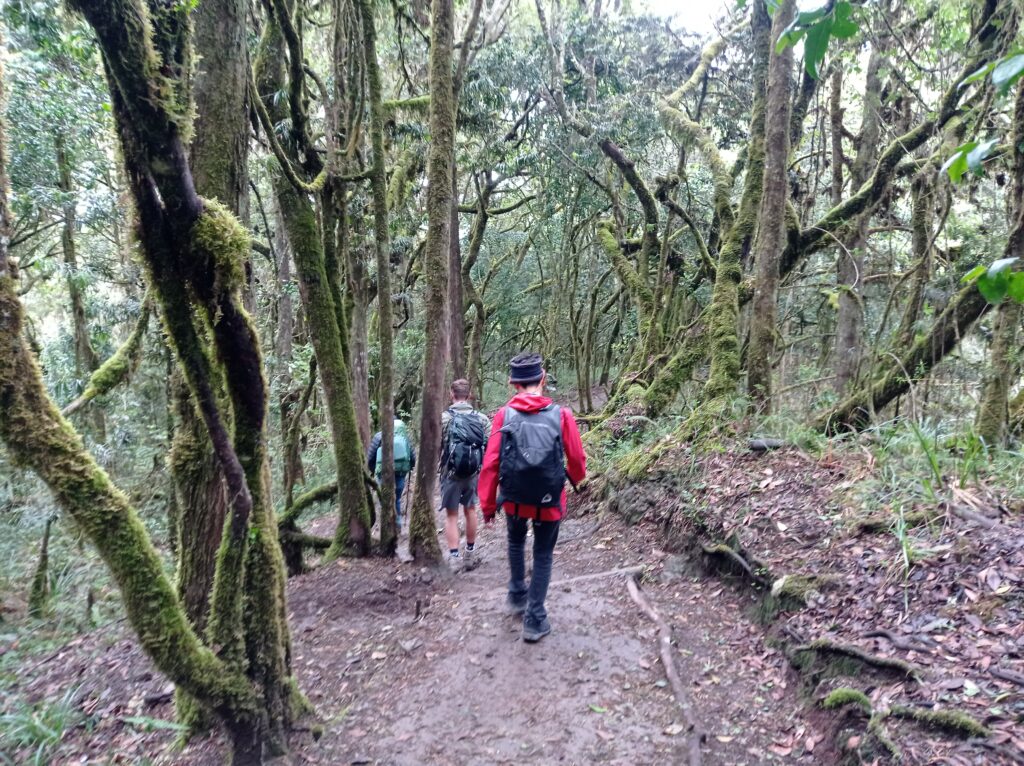




The past few days had been exciting and memorable. But now I was looking forward to more relaxing holiday activities.
* Overall climb and descent as calculated from GPS data. Numbers seem exaggerated, because GPS altitude measurements have a lot of jitter. Apparently more than the latitude/longitude measurements used to calculate distance.
Comments are closed.